#which actually operates in six other states
Explore tagged Tumblr posts
Link
Discover the latest in Colorado Craft Brewers: Tilray, Odell, and Monster Brewing! Find out how these top brewers are making waves in the industry. Check out the rankings and what makes them standout in the craft brewing world. Cheers to great beer!
#The Brewers Association has released its annual craft brewing industry production report#revealing that three Colorado brewers are among the 50 largest craft brewers in the country. Before digging into the results#it's important to note that an American 'craft brewer' is defined as both small and independent – 'small' meaning an annual production of 6#and then 'independent#' meaning less than 25 percent of the craft brewery is owned or controlled by a beverage alcohol industry member that is not itself a craft#which actually operates in six other states#as well. Ranking sixth overall#Tilray Beer Brands is known as the owner of Breckenridge Brewery in Colorado#having purchased the brand along with several others in the summer of 2023. Ranking 9th on the overall list was Monster Brewing – yep#it's part of the well-known Monster Beverage Corporation. Monster Brewing operates breweries in five states and is known in Colorado for Os#the third brewer on the 'top 50' list is Colorado through-and-through – Odell Brewing Company#ranking 25th overall. Find Odell in Fort Collins. Read the full Brewers Association report here.#Colorado brewers#craft brewing report#Breckenridge Brewery
0 notes
Note
Which DBZ antagonist do you like the most?
Boring opinion, I know, but I gotta give it up for the Obvious Choice.

And I'm not just saying that because I haven't had a chance to talk about him yet.
Frieza runs a real estate empire that carries out genocidal acts of gentrification, purging tracts of land of their native inhabitants so he can sell their land for profit. Commenting on this choice for his ultimate villain, Akira Toriyama stated that he made this decision because real estate speculators are the worst people there are.
Fucking based.
From the moment we meet Frieza, he is a monster. Toriyama likes this Big Guy Little Guy dynamic where the Little Guy is the one you really need to watch out for. Frieza is the Littlest Guy ever.
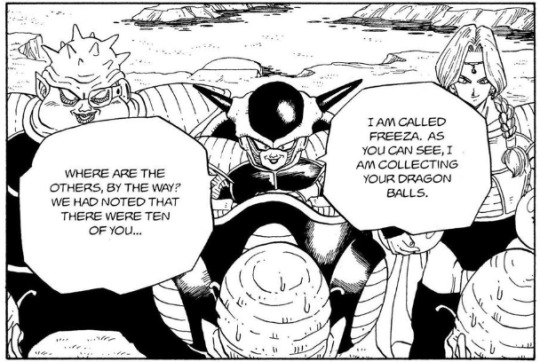
He's so tiny. And yet you know exactly who the most dangerous person in this group is. Zero question.
By the end of this altercation, Frieza reveals one of his signature attacks, giving us our first glimpse of the kind of person and the kind of fighter he is. This is such an important moment for his character and I'm kinda mad that the anime had Dodoria do it instead.
Muri destroys the Scouters and blinds Frieza. I've talked before at length about the devastating impact that this move and the Namekian warriors' attack has on Frieza's campaign.
But once it's done, he has to face the music. He's not getting out of this alive.
In one last desperation play, Muri tells Cargo and Dende to run while blocking them with his body. And that's when it happens.

This is Frieza.
Specifically, this is Frieza's Death Beam. It's never actually given a name, but is generally referred to as Death Beam. We've seen a move like this only once before.
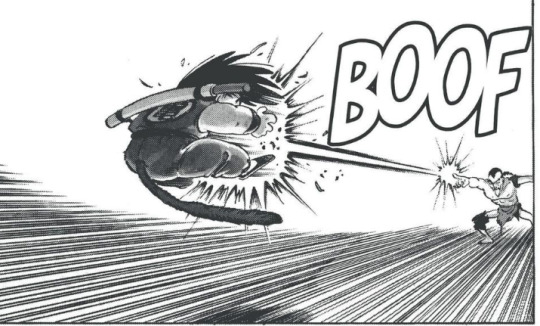
The Dodonpa, signature technique of Tsuru-senryu, first introduced by the assassin Taopaipai, was built for extreme lethality. This is not a technique for fighting; It's a technique for killing.
What makes Frieza's Death Beam stand out from the Dodonpa, however, is its accuracy and its speed. He threads the needle around Muri to hit Cargo before anyone even has a chance to react.
We see its accuracy and speed again six days later, when it finally catches up to the other child fleeing from him here.


The panelwork here calling attention to everyone's reactions as Frieza's ki bullet shoots past them, as his shot threads the needle between all obstacles in his path to strike his target far behind them. Dende is dead before anyone can even process that Frieza fired.
This is the difference between the two techniques. The Dodonpa is a gun. The Death Beam is a sniper rifle. Faced with the physical hurdle of bodies impeding his path, Frieza point-clicked Cargo and Dende to death.
He later executes Vegeta this same way.
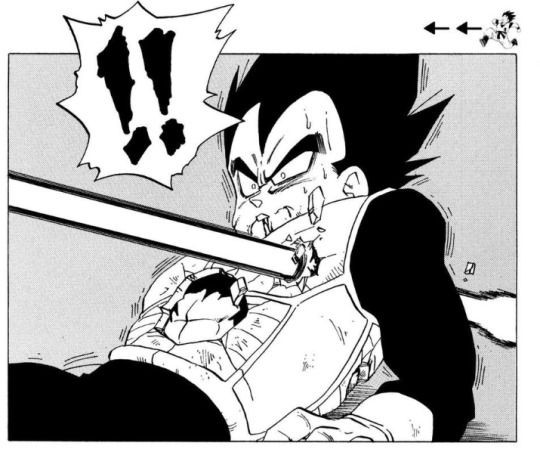
Done with you.
All of this context for Frieza's sniping shot serves to set up the stunning subversion when Goku arrives to fight.
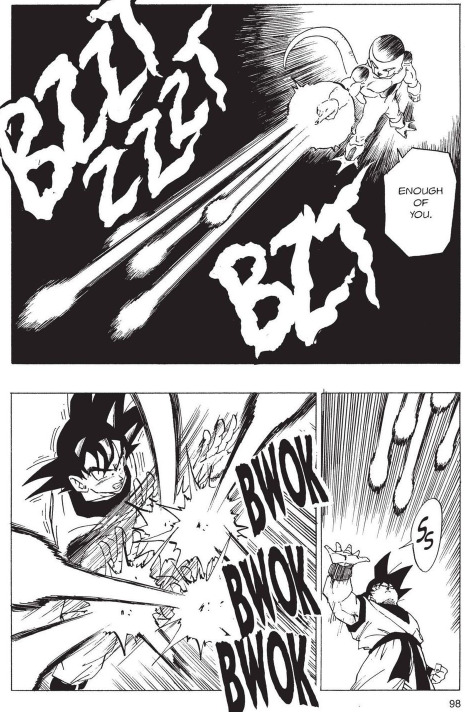
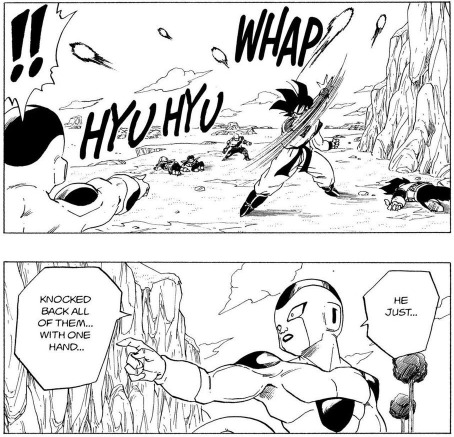
Frieza's never seen this before. Goku shouldn't even be able to see the shots coming until they've perforated his lungs. That's how Death Beam works. It's this moment that lays it out: Frieza's about to be tested like he's never been tested before.
Speaking of cool techniques, I've always been partial to this move from his Third Form.
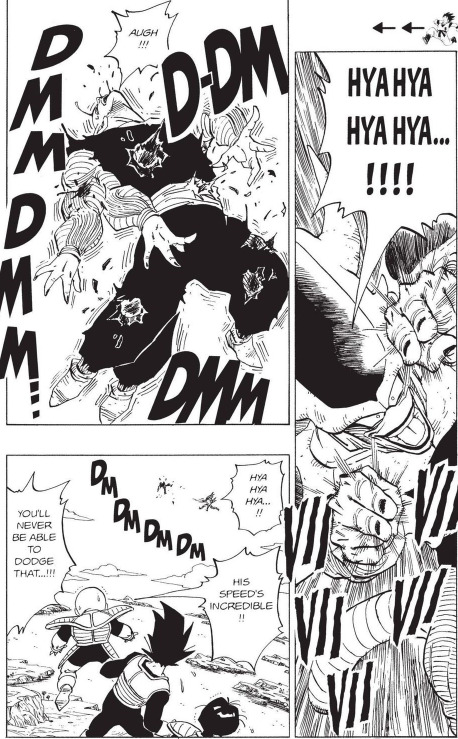
The anime gives Frieza little ki bullets coming out of his fingers but I want to note that we never see a physical projectile when he's doing this. Frieza jams his fingers back and forth in the air while something pulverizes Piccolo.
I've always imagined he's poking the air so fast that it's hitting Piccolo with pressurized air currents. Similar to Goku's Mazoku air current punch from the 23rd Tenkaichi Budokai.
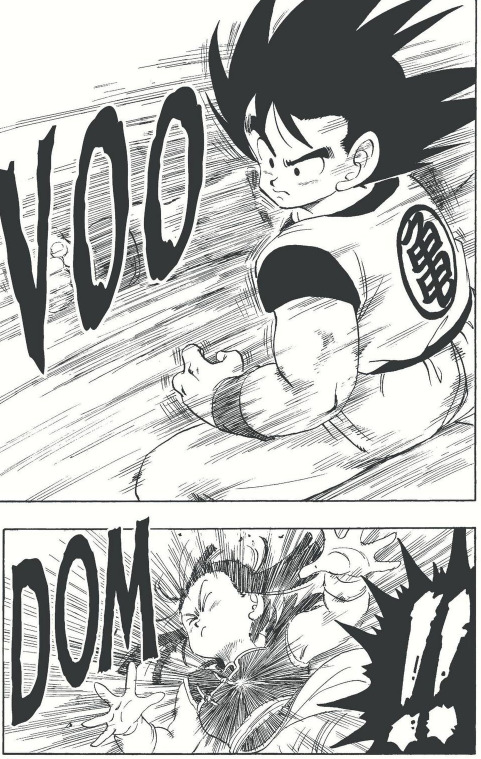
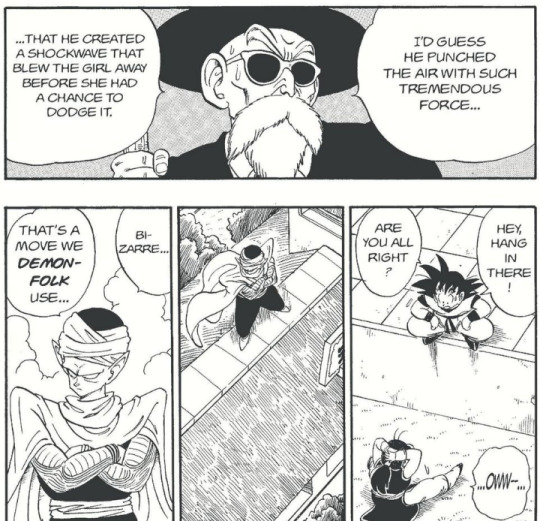
But that's just me.
In any case, Frieza's got some fun moves. He's something of a hobbyist martial artist. Which is to say, Frieza has an interest in martial arts. In addition to his Death Beam, Frieza's concocted a litany of other interesting techniques.
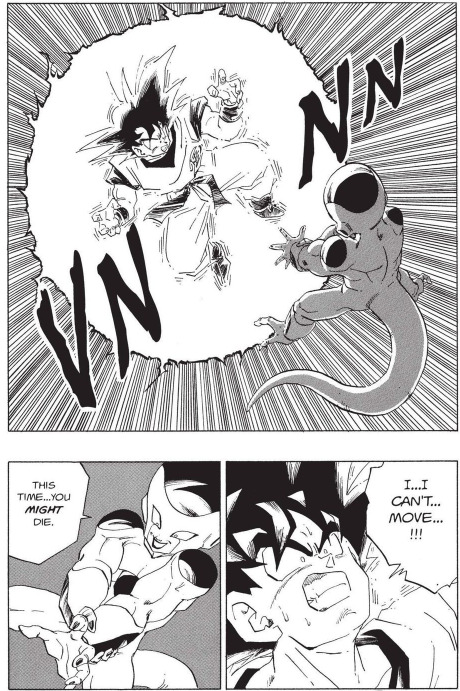
He even invented the Kienzan, independently of Krillin.
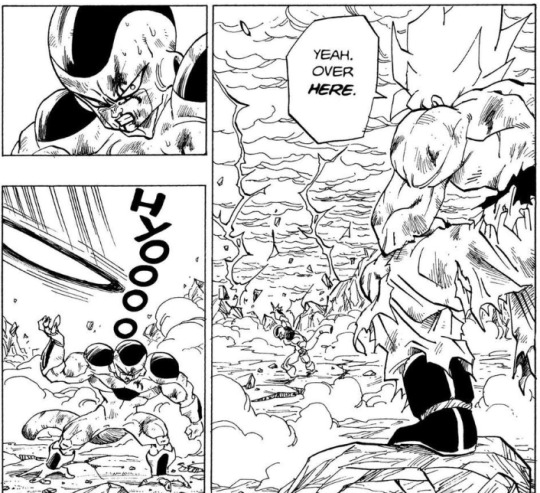
Though he can remote operate his Kienzan so it's strictly better than Krillin's. Frieza, in his spare time, has come up with a bunch of cool moves. Too bad he has no idea how to use them.

Frieza's greatest weakness is his inexperience. He practices martial arts the way a business CEO who bought a log splitter so he can cut some wood and feel woodsy practices agriculture. Frieza has never had a proper chance to truly experience martial arts, because he was born too powerful.
The only partner who's ever even dirtied his skin was his dad.

And even that isn't much. Frieza's too strong. He wants to pursue martial arts. He wants to hone his technique. But when you win every fight by blinking too hard in the opponent's direction, what even is there to practice?
Frieza created a transformation to seal away his immeasurable ki because he was born with so much ki flowing from him that he can't even contain it. At his peak, Frieza's ki bleeds out of him. He simply can't contain it.
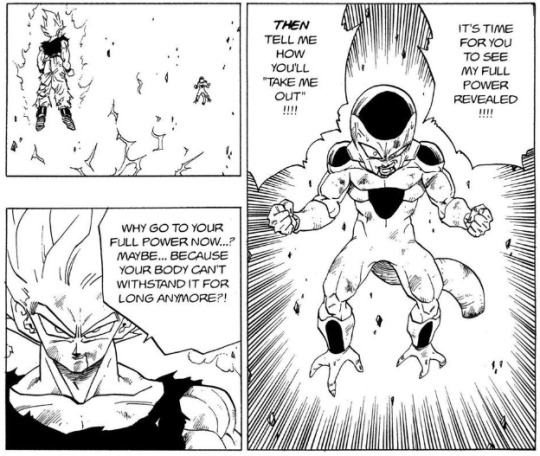
Goku wonders aloud why Frieza took so long, even after the fight turned against him, to go to 100%. Frieza's been all "Oh I'm only using 10% power this is my 50% you made me go to 75%" and Goku's like, "Okay. My dude. What's this about, for real?
This, incidentally, is not a great translation. What Goku's saying here is supposed to be basically, "Perhaps when you use your full power, your body can't handle it."
He is correct.

Frieza's Full Power has a lot in common with Super Saiyan 3. His theoretical maximum ability is wildly different from the reality of what he's capable of, because he bleeds ki like it's going out of style.
So, while other characters wound up earning transformations that make them more powerful, Frieza created a transformation to seal away some of his incomprehensible ki.
Then he created a couple more because even though he could now control his strength and even manipulate the amount of ki he's releasing at a time, he was still too powerful for anyone to ever compete with and needed even more ki sealed away.
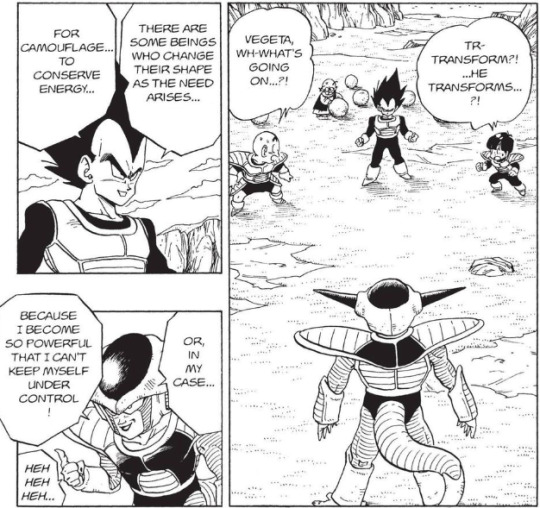
Again, not a fantastic translation from the people who brought us "bottom-tier boy", as Frieza's statement here could be interpreted as saying that he gets taken by a berserker rage or something.
What he's saying is more like, "My power is so great that I can't properly contain it."
Point is, Frieza transformed to lock down his ki and seal parts of it away, so he could control the rest better. Then he kept going, locking away more and more and more of his ki. And even at his most nerfed, he's still five times more powerful than the Second Strongest Guy in the Universe.
Frieza has never in his life had the opportunity to be pushed. That's what makes Goku so enthralling to him.

Frieza plays with Goku because he's genuinely having the time of his life. This guy can fight him in his Final Form. Nobody can fight him in his Final Form. He's so happy, he straight-up forgets that he's trying to complete a genocide against Goku's entire race.
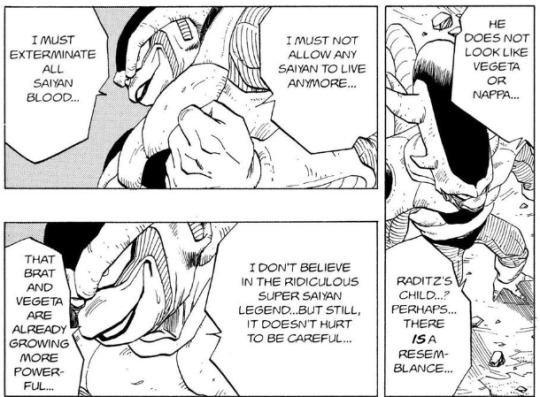
He said that five minutes ago. Gohan's hidden power freaked Frieza the fuck out. Saiyans are too strong now. They've gotten too strong. Frieza cannot permit them to keep existing because they're getting strong. Every last Saiyan, every last one, must die. Every single one. Scorched earth, no survivors.
But then he meets a Saiyan martial artist who's a technical master and pushes him more than he ever thought possible and suddenly:
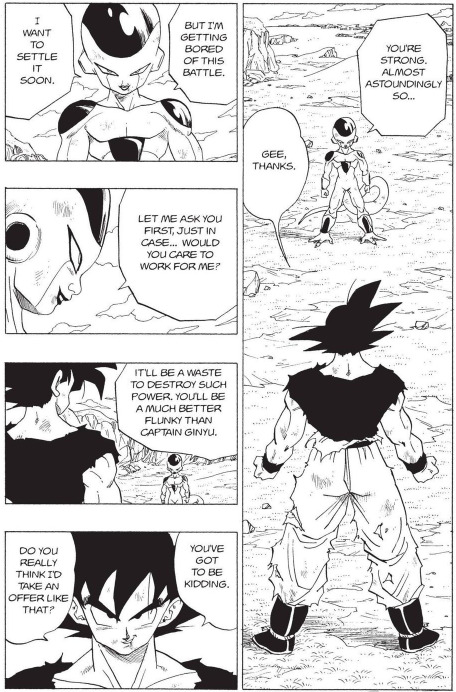
He goes from "Saiyans are TOO STRONG and they all must die because they might threaten me" to "OH MY GOD I'M HAVING SO MUCH FUN CAN I KEEP YOU!?"
It's this desire for a true rival, this opportunity to satisfy his amateur's curiosity about martial arts, that ultimately unravels him. Frieza has one ruthless and pragmatic option for ending this fight once it starts to be too much for him. He can technically stop the fight any time he wants.

But he can't bring himself to do it. He wants to fight. He wants to compete. Frieza's been on the outside looking in at martial arts for his entire life and even when his greatest fears are fulfilled and the Super Saiyan is in front of him, he wants to try.
So when he does attempt to pull his Lethal Ragequit, he pulls back at the last second. He can't bring himself to do it. Goku initially assesses that Frieza held back out of fear of hurting himself.

But later, as Frieza begins unlocking the final chains on his ki, Goku changes his assessment. Noting that if Frieza really held back simply out of a mistake, he could have shot the planet again at any point to finish the job. He's been letting this play out because he can't bring himself to end the greatest fight of his life that way.

This fight is still happening because Frieza wants to compete. I mean, he wants to win, of course, but he wants to win as a martial artist. He's never truly gotten to be a martial artist before.
He is not the guy winning the gold medal at the Tenkaichi Budokai. He has never been that guy. He's the guy who buys up the land the Tenkaichi Budokai is held on and then bulldozes all the people off of it. But in his heart of hearts, he wants to be that guy. That guy is so cool. Frieza wants to play too.
In a sense, by hosting the Cell Games, Cell got to live Frieza's greatest fantasy.
This is who Frieza is. He's the cruel and wicked heir to Genocide Realtors Inc., who is in love with the idea of being Tenshinhan - A desire that exists at odds with - and undermines - his pragmatic business sense, so to speak.
He is the most vile character in the history of Dragon Ball. The worst kind of person. He is also an overeager child whose wealth and privilege prevents him from ever truly enjoying his hobbies, to an extent that he'd be almost pitiable but for all the genocides.
And he is Dragon Ball's greatest villain.
1K notes
·
View notes
Text
African poverty is partly a consequence of energy poverty. In every other continent the vast majority of people have access to electricity. In Africa 600m people, 43% of the total, cannot readily light their homes or charge their phones. And those who nominally have grid electricity find it as reliable as a Scottish summer. More than three-quarters of African firms experience outages; two-fifths say electricity is the main constraint on their business.
If other sub-Saharan African countries had enjoyed power as reliable as South Africa’s from 1995 to 2007, then the continent’s rate of real GDP growth per person would have been two percentage points higher, more than doubling the actual rate, according to one academic paper. Since then South Africa has also had erratic electricity. So-called “load-shedding” is probably the main reason why the economy has shrunk in four of the past eight quarters.
Solar power is increasingly seen as the solution. Last year Africa installed a record amount of photovoltaic (PV) capacity (though this still made up just 1% of the total added worldwide), notes the African Solar Industry Association (AFSIA), a trade group. Globally most solar PV is built by utilities, but in Africa 65% of new capacity over the past two years has come from large firms contracting directly with developers. These deals are part of a decentralised revolution that could be of huge benefit to African economies.
Ground zero for the revolution is South Africa. Last year saw a record number of blackouts imposed by Eskom, the state-run utility, whose dysfunctional coal-fired power stations regularly break down or operate at far below capacity. Fortunately, as load-shedding was peaking, the costs of solar systems were plummeting.
Between 2019 and 2023 the cost of panels fell by 15%, having already declined by almost 90% in the 2010s. Meanwhile battery storage systems now cost about half as much as five years ago. Industrial users pay 20-40% less per unit when buying electricity from private project developers than on the cheapest Eskom tariff.
In the past two calendar years the amount of solar capacity in South Africa rose from 2.8GW to 7.8GW, notes AFSIA, excluding that installed on the roofs of suburban homes. All together South Africa’s solar capacity could now be almost a fifth of that of Eskom’s coal-fired power stations (albeit those still have a higher “capacity factor”, or ability to produce electricity around the clock). The growth of solar is a key reason why there has been less load-shedding in 2024...
Over the past decade the number of startups providing “distributed renewable energy” (DRE) has grown at a clip. Industry estimates suggest that more than 400m Africans get electricity from solar home systems and that more than ten times as many “mini-grids”, most of which use solar, were built in 2016-20 than in the preceding five years. In Kenya DRE firms employ more than six times as many people as the largest utility. In Nigeria they have created almost as many jobs as the oil and gas industry.
“The future is an extremely distributed system to an extent that people haven’t fully grasped,” argues Matthew Tilleard of CrossBoundary Group, a firm whose customers range from large businesses to hitherto unconnected consumers. “It’s going to happen here in Africa first and most consequentially.”
Ignite, which operates in nine African countries, has products that include a basic panel that powers three light bulbs and a phone charger, as well as solar-powered irrigation pumps, stoves and internet routers, and industrial systems. Customers use mobile money to “unlock” a pay-as-you-go meter.
Yariv Cohen, Ignite’s CEO, reckons that the typical $3 per month spent by consumers is less than what they previously paid for kerosene and at phone-charging kiosks. He describes how farmers are more productive because they do not have to get home before dark and children are getting better test scores because they study under bulbs. One family in Rwanda used to keep their two cows in their house because they feared rustlers might come in the dark; now the cattle snooze al fresco under an outside lamp and the family gets more sleep.
...That is one eye-catching aspect of Africa’s solar revolution. But most of the continent is undergoing a more subtle—and significant—experiment in decentralised, commercially driven solar power. It is a trend that could both transform African economies and offer lessons to the rest of the world."
-via The Economist, June 18, 2024. Paragraph breaks added.
#one of the biggest stories of this century is going to be the story of the African Renaissance#I promise you#well preferably they'll come up with a non-European term for it lol#but trust me it WILL happen and it will be SO good to see#africa#south africa#nigeria#kenya#solar#solar power#solar panels#solar pv#energy#clean energy#poverty#electrification#distributed energy#electricity#infrastructure#hope#solarpunk#good news#solar age#<- making that a tag now
411 notes
·
View notes
Text
At the end of January, clips from a film about the housing market in Russian-occupied Mariupol began circulating on TikTok and X (formerly Twitter). After the start of Russia’s full-scale invasion of Ukraine, the Russian army held Mariupol under siege for 85 days, all the while relentlessly pummeling the city with missile and air strikes. Mariupol was effectively reduced to rubble, and no one knows how many lives were lost — though some estimates place the number as high as 100,000. As soon as the Russian authorities had captured the city, they set about rebuilding it and erasing any trace of war crimes.
The film, titled “Shocking Prices for Apartments in Mariupol — Millions for Ruins” was released in November on the YouTube channel “Mirnyie” (the plural form of “peaceful” in Russian and the first part of “peaceful inhabitants,” a Russian term used to distinguish non-combatants from military personnel in conflict zones). The Mirnyie project is led by “war correspondent” Regina Orekhova, a journalist from the Russian state news agency RIA Novosti. In 2022, she received a special award from the Russian Union of Journalists for “courage in fulfilling journalistic duty.”
The Mirnyie project, as one might surmise from its name, explores the lives of ordinary people in the conflict zone. “These are the stories of people who found themselves caught in the crossfire — some left, while others stayed. [We share] their experiences, how they survive, and what they think about,” reads the description. Judging by the channel, Orekhova primarily works in Mariupol. Previous reports of hers cover topics such as Azovstal’s underground tunnels, the sea port, city maternity hospitals, and the drama theater, which was destroyed by a Russian airstrike while an estimated 1,000 civilians were sheltering there.
In the introduction to the half-hour film, Orekhova promises to answer the following questions: “How do you buy an apartment in Mariupol? Is it more profitable to invest in ‘ruins’ that you can resell once renovated? How do you rent commercial space for a business here and how much does it cost? What kinds of apartments are for sale and what determines the price?” Orekhova explains that in Mariupol, there are “damaged buildings” as well as “brand new and renovated ones.” “The real estate market is very unconventional. We’ve studied it in detail and we’ll tell you all about it,” she promises.
Orekhova speaks with three local realtors who show her properties for sale in different parts of the city. As it turns out, these are mostly half-destroyed apartments, hastily abandoned by residents who left all their personal belongings behind as they fled. However, even such properties, according to the realtors, are in high demand. In some cases, actual ruins, where just parts of the walls survived the bombings, are for sale. However, Russian construction companies will restore these buildings later for free, which significantly increases prices. There’s also the rare property untouched by war, or newly renovated apartments in restored buildings. Prices for these range from four to six million rubles (about $50,000-$66,000). Apartments in historic Stalin-era buildings in the center of Mariupol with surviving inner courtyards (i.e., enclosed parking), renovated entrances, and sea views are considered premium housing.
The film doesn’t explain why or, more importantly, by whom all the housing in Mariupol was destroyed. Realtors talk evasively about “all those events” or “military actions.” Orekhova asks how many real estate agencies are currently operating in Mariupol. “Well, there aren’t many surviving citizens per square meter, you could say, but they exist, of course,” a realtor answers.
Showing a damaged three-room apartment in the center of Mariupol, real estate agent Natalia remarks that “one shouldn’t focus on the consequences of what happened to the apartment but on the apartment’s potential.” There’s no electricity, the ceiling is leaking, and personal belongings, including toys and a highchair, lie strewn about — but the windows have been replaced. Natalia points out the “magnificent view” from the balcony. “These buildings have survived more than one war and, as you can see, are still standing,” Natalia says encouragingly. According to her, it would be too painful for the previous owners to come back and see their home like this, which is why they’re looking to sell the apartment in its current condition.
The realtors say that apartments are mostly bought by newcomers “from big Russia” and bemoan that locals can’t afford newly constructed housing. According to them, Russian authorities introduced a special two percent mortgage rate for people from the self-proclaimed “Donetsk People’s Republic” and “Luhansk People’s Republic” who have Russian citizenship. But locals can’t get approved because most aren’t officially employed — there are no jobs with decent salaries in Mariupol.
Luisa, the head of a real estate management company, explains that it’s virtually impossible for Mariupol residents to get an apartment without Russia’s help. She says they “can’t afford to buy back their old homes in Mariupol or to purchase new ones.” When new construction is put up where their destroyed homes used to be, the mortgage payments are out of reach. Luisa recalls how an apartment building in the center, leveled in the bombings, was cleared away to make room for new construction. Residents were offered housing somewhere on the outskirts as compensation, but they weren’t able to buy apartments in the new building being built on their property, even though they’re legally registered at the address.
Tatiana, another realtor, thinks everything in Mariupol is “getting back on track.” She says people are returning, “even those who didn’t plan to.” “The demand [for apartments] is very high, much higher than the supply,” Tatiana explains. “If an apartment is in poor condition but at a good price, it goes quickly. The interested buyers are mainly newcomers. People from Siberia are also eyeing our seaside breeze.”
Tatiana tells Orekhova that everything is “looking up” for the city:
Mariupol has never experienced such rapid growth. The city is developing before our eyes. It’s happening in such a way that even we don’t know where things will improve tomorrow, where slums will turn into upscale neighborhoods. Because our sky is blue. When I say this, everyone smiles, actually. But before, our sky used to be gray or brown, never blue. And now life is getting better; every cloud has a silver lining. You just don’t want to remember the military operations; you go numb. But when you see what’s happening in Mariupol — everything will be fine, everything will work out.
130 notes
·
View notes
Text
I'd Do Anything (... But I Won't Do That)
This started out kind of weird and petty but then turned into an actual thing about the relationship of Viren's character arc(s) to the Arc 2 "I'll do anything for you" theme, because that's actually pretty important for the context of how both Callum and Claudia will have to confront the same conflict.
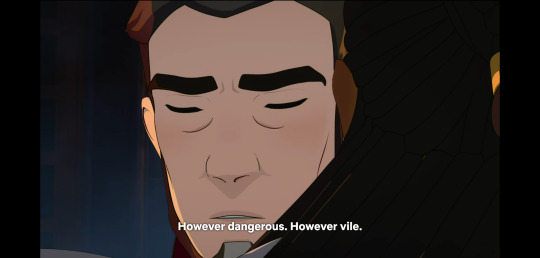
Pictured: Do NOT take a shot every time we get a callback to this line, you will die.
Basically, the petty part is that I think evaluating Viren's Arc 1 decisions through the "I will do anything for my family" lens is... disingenuous is too strong a word, but maybe simplistic? The "Viren doesn't reveal/offer the egg to save Harrow's life because he's too preoccupied with hanging on to his own power" take has never sat right with me because the real core problem of Viren is a lot more complex than just "he's lying (to himself)," it's a whole pattern of denying his own agency in doubling down on his mistakes. He'll make one bad/selfish decision, and it becomes a cascade of subsequent actions that he sees as being unavoidable, but that aren't necessarily even informed by the same reasoning or values as the initial decision. Like everything else in Viren's dream, Kpp'Ar's take that his choices are all oriented toward power is both accurate and not necessarily as literal as it seems.
Because, like... Viren's not actually a manipulator or even much of a planner—he's a very skilled opportunist. That's why all his choices wind up being based entirely on the context of past choices, and frequently make no sense when you look at them from a "hey buddy, where exactly do you think you're going with this" angle. It also contributes to why he's so desperate for control all the time, in that he acts primarily in a reactive way rather than proactively, which is always an inherently less secure position.
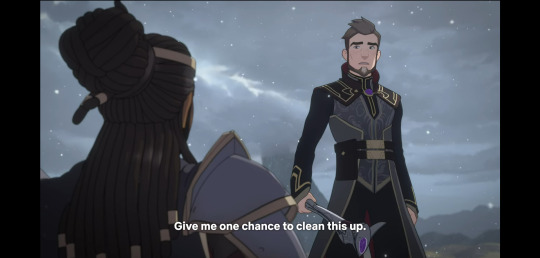
Pictured: The kind of statement that definitely always leads to things going super well.
Even taking the egg in the first place is a reactive decision—not that he doesn't make a choice there, or that he doesn't choose power over the threat he believes the egg poses, but he did actually walk all the way up the Storm Spire, fight five or six Dragonguard, and get kicked down a flight of stairs with the intent of destroying it. He didn't argue with Harrow about destroying it while secretly planning to take it for himself. He only even thinks of it as a weapon because Tiadrin planted the idea in his mind—as an opportunist, the temptation to leave an avenue to power open rather than close it off is what he can't resist. He sat on Sarai's last breath for ten years waiting for a chance to weaponize it to maximum effect, he can sit (figuratively... or literally, I'm not gonna stop him) on the egg for as long as it takes for an appropriate use it to appear. Tiadrin even specifically encourages that he not "waste" it, both specifically by destroying it now, and implicitly by using it too quickly and foolishly.

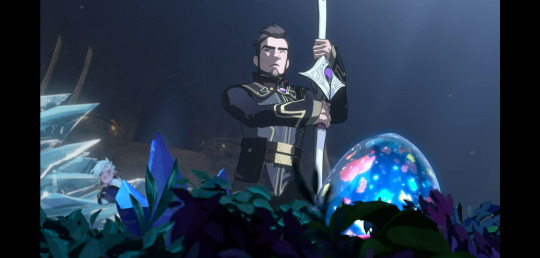
Pictured: Smart mom, dumb ass.
Tiadrin's angle, of course, is that the longer Viren hangs on to the egg without actually using it, the higher the chance it can be recovered. She doesn't know that Viren will leave things in a state where the assumption is that the egg was destroyed, meaning no one will think to try recovering it, but that's not really her fault and it still pays off.
The gamble Viren makes, on the other hand, is that the opportunities the egg affords will be worth the risk of it somehow falling back into Xadian hands. If the egg returns to Xadia alive, he's back to square "his name will be vengeance" in the game of We Killed the Dragon King. So yeah, you could say Viren values keeping the egg over Harrow's life, but in doing that he's actually operating largely on the exact same values and beliefs that made him argue for destroying it in the first place. It's just that his prior choice of risking humanity's security for the sake of potentially world-altering power has backfired in the context of an immediate and direct threat to Harrow's life. Really, the entire rest of s1 and s2 are him doubling down specifically on keeping the egg from returning to Xadia while also milking the opportunities coming from that course—e.g. the egg cannot go back to Xadia, therefore Callum and Ezran cannot return to Katolis either with or without it (knowing their goal is to return it to Xadia, which it will be difficult to stop them from doing once Ezran is king), and that means someone has to take the throne. If the egg can't be recovered, their only hope is a decisive first strike against Xadia, so someone has to mobilize the Pentarchy immediately. None of them are things he planned in the sense of "well, if Harrow dies then I can get his sons out of the way and make myself king, and then conquer Xadia." It's all reactive to the situation with the egg. You could argue that he'd do the same things if the egg wasn't a factor, like it's possible he's always been kind of lying in wait to push Harrow's sons aside and seize the throne... but if that was the case, he'd really do much better to make a bid for regent like any normal evil advisor would.
Anyway, all of that does still undermine the statement that he'd do "anything" for his family (which includes Harrow), and it is ultimately because of that initial choice he made to take the opportunity of power over the certainty of securing humanity's future. It's just not as simple as, "Viren says he would do anything for his family, but he won't sacrifice his own power and ambition." In the wake of his critical failure to prioritize humanity in destroying the egg, he's making choices that do prioritize humanity (from within his worldview that Xadia is an existential threat barely held at bay)... but they're still bad choices because they're all reactive to that original bad choice. It's not that he's working at cross-purposes to what he says his goals are, it's that he genuinely thinks digging his hole deeper will somehow work out positively, or at least better than the alternative would.

Pictured: Another statement that for sure indicates you're doing totally great.
Really though, I don't think you can (or are supposed to) look at the trifecta of self-individuals-world and point to one that Viren—or really any character outside of Callum, Rayla, and Claudia—puts at the top. Part of the whole point here is that elevating one of those at the expense of the others is never going to be the right choice all of the time. Obviously always putting yourself first is shitty, but we get multiple examples of over-prioritizing one of the other two as being self-destructive and dangerous. Consistency isn't supposed to be positive, here—a core part of this arc is likely to be Callum grappling with that, and that's without even looking at what's going on with Claudia.
The other thing is that "I will do anything for my family"-Viren is actually on some level a different character than Arc 1 Viren, such that evaluating one based on the context of the other doesn't actually make sense. We don't get even a hint of the "I would do anything for my family" in the series until s4, after Viren has died and been revived. Yeah, we had it earlier in the novels, but in there it's really about Claudia and her relationship with Viren, not Viren's values or actions. Arc 1 Viren and Arc 2 Viren inform each other as characters, but most of the point is the ways they aren't the same. And while Arc 2 Viren is understandably preoccupied with the concept of sacrificing for family—given that he's been stripped of everything that was in his life except Claudia, who went to terrible lengths on his behalf—Arc 1 Viren is actually quite consistent with how he's laid out in his Tales of Xadia character sheet:

Like, check out those Liberty and Glory statements—not even close to the same ballpark as Callum's "I value those close to me more than anyone or anything" Devotion and "I'm beholden to my inner circle, not some silly kingdom" Liberty, but quite accurate as the through-line on his s1-s3 actions. There's nothing in there about family, because Arc 1 Viren isn't actually meant to be associated with "I will do anything for my family," and he's not lying to himself by not acting consistently with it in Arc 1.
Arc 2 Viren is then a kind of emotional reboot back to a particular point earlier in his life—not necessarily the point before he first did any dark magic at all, but before he did his ill-defined "anything" to save Soren, which is implied in multiple places to be the point where he started in on a spiral that had tangible and fairly rapid effects on his personality and outlook. That's further emphasized by the contents of his dream in s5—seeing him behave in a genuinely loving and joyful way with Soren is shocking, and immediately raises the question of what the fuck happened and why.

Pictured: Healthy coping mechanisms.
Part of what still distinguishes Viren's "I will do anything for my family; however dangerous, however vile" from Callum's developing "I would do anything for you" is that Viren is always deliberately addressing the "things that are so unforgivable, you will never forgive yourself" facet while Callum leaves it implicit because he doesn't really understand and/or want to acknowledge that yet (and also Rayla would probably twist his nose again, which fucking hurts). In how Viren describes it to Terry, he is using that up-front acknowledgement to then essentially abdicate any emotional responsibility for... well, anything at all. The entire "however dangerous, however vile" mantra is another way of denying his own agency, because if he'll do anything, then he doesn't actually have to go through the difficult emotional process of making those decisions and dealing with the aftermath.
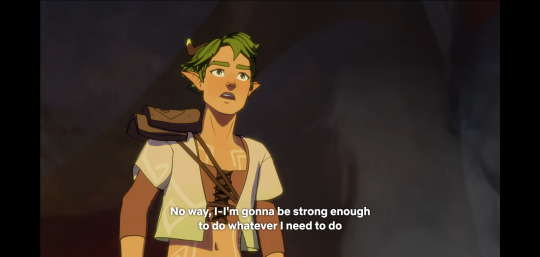

Pictured: H-healthy coping mechanisms?
Terry correctly pegs this questionable excuse for philosophy as "not having feelings," and generally not the best approach, because it will do things like lead to a default state of emotional unavailability to your children—oh, wait. I think it's not unlikely that Viren's emotional distancing from what "I will do anything for my family" meant contributed a lot to the degradation of it as his core value and his ensuing Arc 1 state. A lot of what's going on in his s5 dream is that he's being confronted with the consequences of "I will do anything for my family," specifically. He's being forced through an emotional speedrun of what it has cost him and everyone around him, and what has he got to show for it? Claudia, corrupted beyond recognition, proudly repeating his own words back to him.

Pictured: Whatever the opposite of daddy issues is.
Because the whole point of Viren's "I will do anything for my family" in Arc 2 is the challenge of whether he would/will do it all again. If he holds to that value the same way he did before, he'll do whatever it takes to save Claudia—however dangerous, however vile. Most of Viren's moral and emotional stuff has been based on his self-serving resignation to having "no choice." He's so tragically trapped in a chain of spiraling consequences he can never break... except oh wait, he totally can. S5 is all about Viren recognizing the dark magic feedback loop and that he has the agency to break it, and his best and only chance to avoid doing further harm to Claudia is to not be willing to destroy himself that way again, even it it means his death will cause her terrible emotional pain.
We'll see how that works out. Because let's be real: Claudia's gonna Claudia, regardless. However it goes, there's an important narrative precedent being set for both breaking free from dark magic/Aaravos and evaluating the "I will do anything for you" impulse in a more nuanced way.
#the dragon prince#viren#thanks for coming to my petty TED talk#also like... do not even pretend that handing over the egg would have worked#or even more emphatically that VIREN would ever have considered handing over the egg as something that would work#the entire point of the cycle-breaking narrative is that the new generation has broader and more compassionate vision#while the old generation is stuck in The Cycle(tm) and therefore incapable of making OR accepting that offer#it would not just be wildly out of character but literally antithetical to the narrative itself for Viren to think it's a viable possibilit#kradogsmeta
57 notes
·
View notes
Text
hauntingly relaxing basslines to grow/disappearify pumpkins to
(page 818-825)
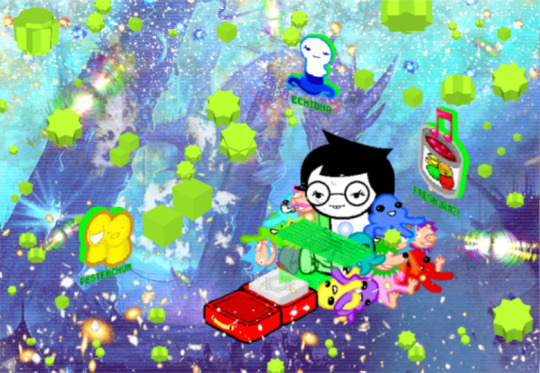
Jade irradiates a tasty dinner for Bec, leaving it full of ‘nice depleted steak isotopes’ (p.819). I was wondering about the science behind this, and learned that while radioactive decay naturally gives off heat, it’s probably not enough to cook a steak. Radioisotope thermal generators convert the heat of radiation into electricity, and there’s a lot of theory about radioisotopic batteries that could operate similarly to solar cells, but their efficiency is below 2% in laboratory tests.
This got me thinking about Skaia as a perfect conserver of energy – on page 193, Rose expends six units of build grist to construct three Perfectly Generic Objects. On p.261, she deletes them and regains six build grist. Next page, she uses the recovered grist to build a platform extending from John’s house, and finally on p.485 turns that platform back into six grist to build more stairs. In the real world, there is always a loss of energy and raw materials when changing something’s form, and many games model this (for example, an in game item costing 100 gold but only sold back for 50) to discourage players changing their minds. But Sburb explicitly allows for this experimentation, and a similar principle could explain why Jade’s uranium powered devices are so efficient.
Speaking of Jade’s technology, we see her ECLECTIC BASS, which is a kind of triple keytar. It definitely does not need to exist but it is so cool that it does. Jade (via the narrator) is frustratingly vague again with ‘obviously it's too complicated to play it in person like this’, refusing to clarify what ‘in person’ means, but I’d guess it’s a remote controlled hand or several that can play bass remotely without the limitations of human fingers. Possibly controlled through her other invention: the computer.
Instead of a regular desktop, Jade’s LUNCHTOP works through beams of light emitting from small floating polyhedrons, positioning her literally within the digital space. Amidst floating clouds, extra pixels and jpeg debris, and spinning chromosomes of light is a cool dragon as a wallpaper, icons for Pesterchum, Echidna (probably a browser) and Fresh Jamz!, which has an icon of a musical note over a jar of fruit jam. Is Jade a composer too? Did she write her own hauntingly relaxing bassline that caused the plants to grow? Is this a hobby she and Dave have in common?
Jade’s hauntingly relaxing bassline (p.822) is a great companion piece to WV: Ascend, showing Jade’s island in its current state as opposed to in extended timelapse. The house, with its orbs atop spires, is clearly modeled on a now broken part of the frog statue, and was designed to fit in with the existing architecture and shape of the island (it forms a peak to the small second mountain). The house was built for aesthetics, not function, and is primarily vertical especially towards the top. No wonder Jade ‘almost never use[s] the stairs’.
Putting the timeline together, we know that Jade is about to message John at 16:34 his time (p.110), but they don’t actually talk until 17:25 (p.169), almost an hour later, at which point there’s an explosion outside Jade’s house. In page 822’s animation, an aeroplane flies low over Jade’s island and drops off a delivery (a blue package – something from John, perhaps?). This must be an uncommonly loud sound in a remote area. Depending on how this flash syncs with the timeline, this may or may not be the ‘explosion’. Either way, Jade will be on the computer during the explosion, and as her likely homemade computer involves complete immersion in the digital surroundings, I can believe that she would interpret a noise from her computer as something that’s happening outside her house.
We’ve explored Jade’s room, interests, musical talents, fetch modus, and now computer. In all of these she’s been set up differently to her friends. We have yet to explore the rest of her house and its surroundings (featuring, presumably, strange themed decor, a large humanoid doll and a piece of visual art Jade has created) and to meet Jade’s grandfather, witnessing her attempts to evade and eventually strife with him.
> Jade: Open Echidna and watch your favorite Squiddles episode.
22 notes
·
View notes
Note
the state of israel MUST be dismantled for a free palestine. jews existed and lived in ME before the existence of Israel, and jews will continue to live in ME but Israel as a state has to go. israel didnt bring the jews to ME.
See... the whole "Jews will continue to live" thing is what I'm not so sure of.
I understand where people are coming from when they talk about how Israel as a nation-state must be dismantled. It was established by outside forces, maintained by those outside forces, and has in past decades engaged in some truly heinous behavior.
However, that behavior was enacted by the government, which is not all of Israel, nor even all of the Jews in Israel. That government's behavior also reflects on those people of Israel, and any revenge against the government--which is likely if dismantled--is likely to land on the shoulders of the people of Israel who may not have anything to do with it.
There are pacifists and children in Israel, just as there are in Palestine. There are people protesting the conflict in Tel Aviv and Jerusalem.
Over half of the Jews in Palestine are of a Mizrahi background, and either came to Israel from Arab countries that wanted them gone, or are the descendants of the people who did so. The establishment of Israel by the Sykes-Picot agreement resulted in many countries having a place to send their unwanted Jewish population to, and those countries now had the option of driving out, or at least 'encouraging,' those populations to leave. Operation Magic Carpet wasn't driven solely by the Imam of Yemen; Israel played its own role in it, as did the US and UK, but the result was a mass exodus of Jews. In 2022, there were a total of six Jews in Yemen. Now, there is only one.
Those Mizrahi Jews are also by and large not part of the Israeli government.
Many of the others in Israel are holocaust survivors, or the descendants of such.
It is not a stretch to say that Israel is, statistically, a country of refugees and their children.
Many of the powers most vocal about dismantling Israel are also the most vocally antisemitic. The most obvious example is the Yemeni Houthis, who have "death to all Jews" as a slogan. Hamas is aligned with them, and both are aligned with Iran, and Hezbollah. None of these specific groups want Jews in the ME, period. Some have made it very clear they don't want Jews to live at all, anywhere. It's not 'Jews who support the Israeli state' that they object to, it's Jewish people, period.
My hesitation about the argument to dismantle Israel is that I haven't seen anyone yet talk about how to go about doing it without a risk that there is another mass exodus or mass murder.
Un-fucking-fortunately, that possible result is also what Israel's government is using as their justification for war against their neighbors, and what it has been using for the better part of eighty years.
I am not defending Israel's actions. I do not condone what they are doing in Gaza. I do not condone what they are claiming about Gaza, and I have heard some truly horrifying propaganda that is getting fed to Zionists to keep the fervor up. I do not think that what they are doing in the Occupied West Bank is ethical. I do not think the Israeli government has a leg to stand on in terms of morality and ethics.
I also think that people who say "Israel should be dismantled" are looking at the past and turnabout as fair play without actually asking 'what will happen to the people who live there if a group like Hamas or the Houthi rebels or Hezbollah uses a weak transition period or sudden collapse as a chance to enact that revenge.
I don't know what the correct solution is. Rebuilding a government with both Israeli and Palestine officials in a joint system, unifying the two regions with the UN enforcing a fair and equal election and representation system? The two-nations solution that people have been talking about for ages, booting Israel from the Occupied West Bank and Gaza, and demanding they pay reparations to the people of Palestine? I don't think withdrawing all international interest and support to let them work it out among themselves is the right call. I don't think having Israel take over completely, or Palestine take over completely, is going to end well for whichever community ends up Not In Charge.
I don't know what can be done. I just know that the short, sweet, pithy 'dismantle Israel' and 'Zionism is bad' statements only sound good until you ask 'but where will the Jews, hated by most of the ME for what their government has been doing, and hated for millennia before that for existing, go?'
Which sucks, because Israel's government sure as hell didn't ask where the people of Palestine would go when they started pushing them out.
It's not fair! It's not fair to Palestine that this all is happening. It is not fair that the founded but unrealized risk to Israeli lives is being weighed against the fully realized and ongoing threat to theirs. It is not fair that thousands of children are dying of air strikes and hunger.
Palestine is undergoing a massacre at the hands of the Israeli government.
It is entirely possible that Israel will undergo that same massacre at the hands of Hamas and its allies if the 'dismantling' happens without safeguards.
Israel needs to stop. People are dying in the tens of thousands in Gaza because of their completely disproportionate response. A ceasefire is unquestionably needed and the ongoing refusal of the US government to help enforce one by pulling support from the IDF is a failure.
(No, not the Houthi strikes. That is a related, but distinct situation.)
But 'dismantle Israel' tends to come with few ideas on how to do so without risking the same situation as now, but in the other direction, and with the same or larger possibility of escalating into a wider regional conflict.
I don't know. I don't fucking know. But please understand that I am coming at this from a place of attempted compassion and concern. I am not trying to be dismissive of people's claims. I do not support Israel's actions. I don't even necessarily think Israel, as it is and as it was founded and as it acts, deserves to remain the power and government that it currently is. Restructuring, renaming, integrating, all these things are options, maybe even necessary ones.
I just don't think 'deserve' is the only consideration when the past seventy-odd years have been spent sowing the seeds of hate and revenge, and so many military groups in their area have expressed a desire to see all of them dead.
If you know of a 'dismantle Israel' plan by Palestinians, rather than some random Western Leftist, that includes plans on how to integrate the people that have in some cases been there for decades, and in some cases ended up there because they were driven or 'encouraged' out of neighboring Arab states...
Let me know.
But please recognize that I am trying my best to base my opinions on compassion and ethics and morality and awareness, not just parroting the news without thought, or my echo chamber, or whatever the first take to come to mind is. I am not trying to be malicious. I am not trying to be ignorant. I am not trying to 'stan America' or whatever people have been saying in my ask box.
They bombed me, too.
#Anonymous#I didn't start talking about the conflict in my own words until I felt I had a strong enough grasp on the facts and propaganda#to know what I was even saying.#phoenix answers asks#politics#current events#palestine#israel#gaza#death tw#antisemitism#islamophobia#death mention#genocide mention#ethnic cleansing
56 notes
·
View notes
Text
Anyone who tells a queer person "Just Move to a Better State" doesn't get it.
So, as some of you know I've got an account on Bluesky, one of the social media websites that arose from the ashes after Elon Musk completely fucked up Twitter beyond how fucked it was even on it's worst day.
Recently I shared this article, hoping to spread some good news to my fellow members of the LGBTQA+ community:
And some smarmy jackass replied with this:

Yeah... anyone who says this is an asshole who doesn't get the realities of these situations.
I grew up in Kentucky. Yes, the state where Mitch "the Lich" McConnell was spawned (we're trying to get rid of him but that asshole hid his phylactery really good okay?) As some of you might guess, my own home state has issues with people who try to push these sorts of laws.
I've been told by others, in the past, to just move to a better state.
I tried it once infact, I moved from the Cincinnati Metropolitan Area (I lived right on the border between Ohio and Kentucky at the time) to another city where I was going to live with a gay couple I met online who were friends with my, at the time, partner.
... you probably see where this is going already, but I'll continue.
The city definitely had a good LGBTQA+ presence, but here's the thing. I stayed there only six months before all but fleeing back to Kentucky.
Why?
Several reasons.
NOBODY wanted to hire "the new kid in town." I had a horrible time finding a job that would satisfy my roommate. They knew I had only worked retail in the past and, at the time, had no college under my belt at all. I tried getting jobs in multiple places. I tried getting hired on as a 911 operator, at several higher end stores, and such. You know where I wound up working? A shitty little Circle K station. It was the ONLY place that would hire me and paid a pittance. I could barely help with bills at all.
My roommate was a judgemental asshole. To quote Sir Terry Pratchett, "Just because someone is part of a minority doesn't mean they can't also be a small minded prick." One of my roommates judged me for EVERYTHING. Nothing I did was good enough, and if he found out something he didn't like he would hang it over my head and never stop giving me shit for it. I hated it. I hated it within weeks of arriving but I didn't want to leave because that would be 'admitting defeat' or some bullshit (it was ten years ago, I forget exactly how I justified it.)
I had to give up all the friends and family I had in the move. The part of the country I moved to was a place that I had never been before. I had no friends there, I had no family there. All I had to rely on was my two roommates. One of them clearly didn't want an extra roommate but went along with it because his boyfriend wanted it (I feel bad for him these days,) the other one... see item 2. This also leads into item four...
Because I had no friends and family there, I had no safety net. Asshole roommate constantly reminded me if I didn't get a 'better job' (and good luck to me on that given the circumstances) I'd be out on my ass, in a totally unfamiliar city. I had no help there besides them and he knew it, and he held that over me every chance he got.
Finally, after six months, I managed to move back in with my mother in Kentucky. This story does have a happy ending though. I wound up splitting up with my at the time partner (who in hindsight really wasn't a good match for me, though I hear they're doing much better these days,) and it was the wake up call I needed to get some college education. That didn't go great, but having even partial college on a resume helped me get a job that was far FAR better than retail work which I've held for over five years now.
I realized too that while Kentucky isn't great on progressiveness as a whole... the part of the state I'm from actually is. We're part of the Cincinnati Metropolitan Area (which basically means "if it wasn't for state lines we'd just be part of Cincinnati") and there's actually a really big LGBTQA+ community around here. These days I see Pride bumper stickers everywhere, and there's several houses nearby with Pride flags as well.
In Kentucky. Yes, that Kentucky.
But my point is... even assuming a person CAN move, it doesn't mean that it'll fix everything. In my case those six months were absolutely hellish despite living with a queer couple in a major city. My life only improved AFTER I moved back to Deep-in-the-Red-State Kentucky. Because the part I'm in has a good community, I have friends and family who support me, I have a good job here, and I have a good life here in spite of what some idiot in the state capitol is up to.
In closing, I have this to say: If you hear someone talking about queer issues in their home state and your first instinct is to tell them to just move to California or New York or some other state... just shut the hell up.
34 notes
·
View notes
Text
Thinking about Persona 4 Arena Ultimax
Specifically the Persona 3 side of it.
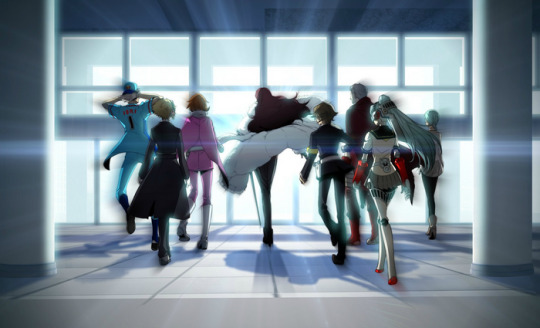
I think it's interesting (and kinda funny) how a lot of the P3 content in this game is built upon the many CD Dramas that released in Japan following Persona 3/FES' releases, specifically the New Moon/Full Moon and Daylight/Moonlight Duologies.

As what's most likely the largest example, Labrys, one of the two major characters introduced in the game, was actually named in the Moonlight CD, which was released back in 2007 (Arena was released in 2012, for reference)
"The 7th Generation, Aigis, was created from all the data we'd obtained from all prior designs up to the 5th Generation, Labrys." (Moonlight)
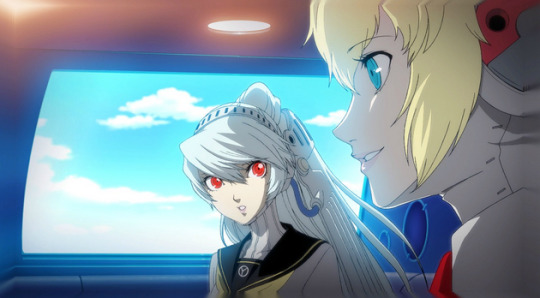
Aigis' and Labrys' motivation of finding their mother is also building upon the story of Moonlight, where Aigis is able to speak with the girl whose personality was one of the bases used for the Anti-Shadow Weapon development project, and who refers to herself as her mother (but looks more like her younger sister).
"That's right... in human terms, I guess I'm kinda like your mother or something? A-ah, but based on our outward appearances, I guess I look more like your younger sister?" (Moonlight)
(For context, she is forced to forget this meeting at the end of the CD, but resolves to meet with the girl in real life. She isn't named, but we're told she has black hair.)

I think Mitsuru is the most interesting, as her appearance in the game is almost wholly influenced by the story of the New Moon/Full Moon Drama CDs, which are a side story covering her and the broader Kirijo Group's situation immediately following Takeharu's death, released in 2009.

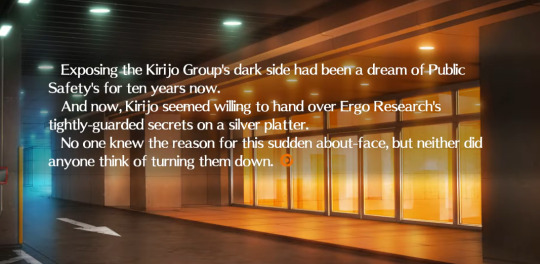
Mitsuru's story opens up with her going public about the bloody past of the Kirijo Group and the existence of the Dark Hour and Shadows. This is following up on her resolution near the end of Full Moon, where she states plainly that this is the path she's going to take.
Ichiro Takadera: "Well then, do you intend to make a public announcement regardless of what follows? About the Shadows and so on?"
Mitsuru: "That is my path in life. I cannot stray from it." (Full Moon)

Kikuno Saikawa, Mitsuru's right hand maid and one of the shadow operatives, also made her debut in New/Full Moon. The two of them met when they were children, and Kikuno vowed to protect Mitsuru after she'd saved her from her despair as a child.
Kikuno: "Six years ago, when I learned my stay at the hospital wasn't because of illness but because I was sold over by my parents, you were the one who saved me from my despair. On that day, I swore I'd devote my life to following this person." (Full Moon)
Ultimax was the first time she was given a design, but she would later appear in the Persona 3 Movie: Winter of Rebirth. Her characterization in Ultimax is pretty faithful to her depiction in the CD.
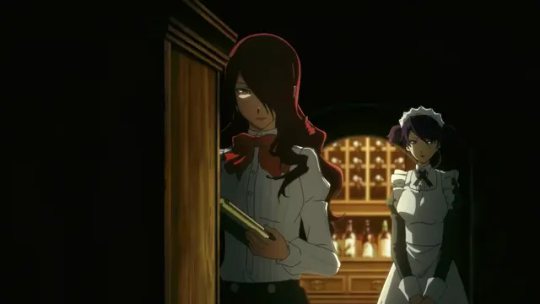
(A fun fact is that Kikuno was also mentioned in the "Seaside Vacation Before Death's Scythe" Drama CD, which was released in 2013 as a promotion for the then upcoming first Persona 3 Movie, Spring of Birth.)

One of the Kirijo artifacts mentioned in Mitsuru's prologue is a ring that gives its wearer immunity to the effects of the Dark Hour. This too is an object introduced in New/Full Moon.
"Also, there is no need to worry, as everyone who are not in possession of special powers, including me, will wear this ring. While it's on you are able to experience the Dark Hour and even when you take it off your memories of it will remain." (New Moon)
Something that doesn't come up in Ultimax is that if you smash the jewel in the center of the ring, you'll lose all your memories of the Dark Hour. It's an interesting little thing! I mean it's. Useless now cause the Dark Hour is gone but it's pretty cool...
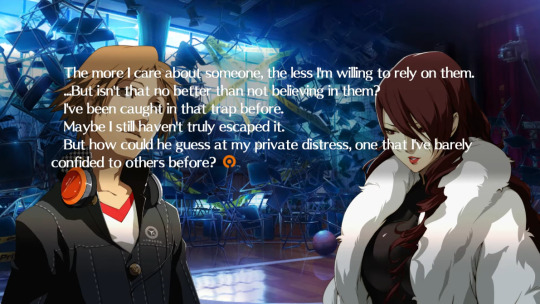
Mitsuru's main internal conflict is her inability to ask others for help for fear of burdening or endangering them. This is something that comes up in Persona 3, but in the Drama CDs this aspect of her character is very deeply explored. It's her main emotional arc and the source of her conflict with Yukari in both the New/Full Moon CDs and Persona 3 Character Drama Vol. 4, which focuses on their relationship.
Yukari: Is your faith in us that weak?
Mitsuru: To be frank, I can't bear it anymore. I don't want others to die for my sake!
Y: And you're gonna sacrifice yourself because of that? Why do you take on so much by yourself? Is that really okay with you? Don't you want to see your friends and family again?! And to survive?! Why can't you just be honest?!
M: Of course I want to! But...that is...what should I say? It's always like that...whenever I get soft or burden others... They might end up dying again. [...] Aragaki, and my Father... What am I supposed to tell you after all that happened? Even if I'm afraid and wish to be saved, what do I say?! What should I say?! (Full Moon)

Yukari even brings up that they've had this talk before. It could be referring to their heart to heart in Kyoto, but I think it could also be read as their conflicts in the CDs too.
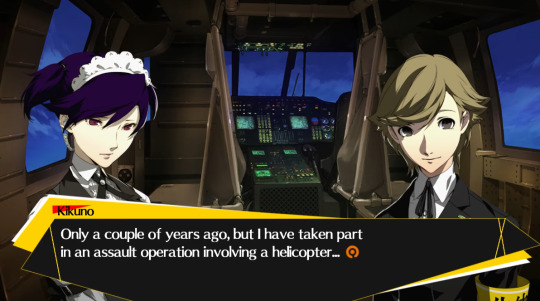

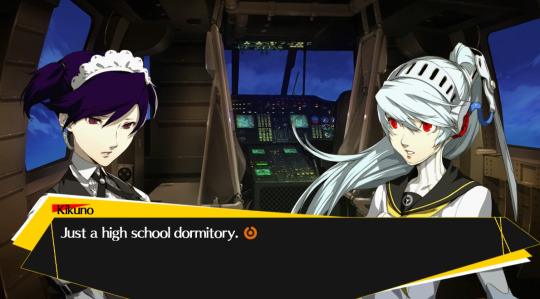
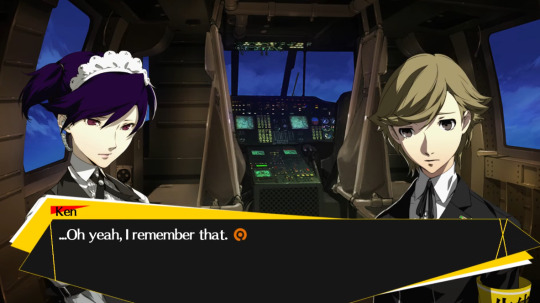

When Ken asks Kikuno where she learned to fly a helicopter, she states that she learned it after being involved in an assault operation on a high school dormitory, an incident which Ken says he remembers. (Say it with me now!) This is most likely referencing the climax in Full Moon, where the Kirijo Group led by Takadera attempt to raid Iwatodai Dorm and forcibly apprehend SEES, so as to avoid the possibility of Ikutsuki's plot and the Group's sins from becoming public.
There's definitely more stuff, but I just wanted to point out the things I noticed/particularly liked with Mitsuru's story.

I think Junpei suffers the most from having a lot of his characterization be taken from the CDs. A lot of people were (and still are) confused about P4AU Junpei's seemingly sudden hard pivot to Baseball, as in Persona 3 proper, it's not a very large aspect of his character.
But in the CDs, Junpei being Into Baseball is MUCH more prominent. As in he refers to everyday situations in baseball terms sometimes.
In Persona 3 Character Drama Vol 2., (released in 2008 and centered around Junpei and Chidori) Junpei dreams about taking Chidori out on a date, and eventually settles on asking her to go to a baseball game with him. (She accepts, if you were curious).
He talks with Chidori about baseball so much that she got into it herself and started watching baseball in the hospital.
At the end of Moonlight, the SEES gang talk about what they want to do after they defeat Nyx, and Junpei says he wants to go to a baseball game. They even kind of tacitly explain why he didn't talk about it all that much ingame by saying he'd fallen out of interest in it but that he "feels like it's returned in full force!"

The thing about P4AU's heavy references to the CDs though, especially in Junpei's case, is that they were never officially translated or released outside of Japan. To this day the only way for non-Japanese speaking audiences to experience the CDs is to listen to them with (usually slightly incomplete) fansubs online.
While I kind of appreciate the novelty of that, it's definitely caused some confusion when it comes to characterization. In P3 Reload, for instance, Junpei makes a lot more references to baseball in his dialogue. And for a lot of people, it feels like the purpose of that is to retroactively make Junpei's appearance in P4AU make more sense.
And while that's not incorrect, it misses the fact that Junpei was already established to like baseball in supplementary material before Arena came out. It's more like making his character consistent with the same material that P4AU used when writing Junpei.
But it's not like you can even blame people for thinking that because a lot of people are normal and don't listen to 16 year old fan translated Drama CDs uploaded to youtube. It's just interesting to me I suppose. I wonder how much characterization we miss due to lack of access to supplementary material.
Anyway you should listen to the CDs though they're really good. New Moon/Full Moon especially.
Moonlight is also very good, it's a pseudo-prelude to The Answer, and the character writing is top notch.
But that's all I had to say, really. Just thought it'd be fun to talk about.
Translation Credits: imaginary_numbers (Moonlight) pipeds (New Moon) pipeds (Full Moon)
#if you're a yukamitsu warrior#watch new moon/full moon#character drama cd vol 4#and moonlight#but the rest are also just really good. the characters feel like their authentic selves#afraid to put this in a persona tag cause i dont want people to yell at me over some perceived inadequacy#they're also very well acted too#like god damn
39 notes
·
View notes
Text
THE LINDASIMS2 RESEARCH AND EXPERIMENTATION: PART SIX
Today, it's finally here, and with proper grammar and punctuation (hopefully!), as my 200th post. The proof that only @lindasims2 could've destroyed her own content.
As a bloody April Fool's joke.
And we've all been blind to it for years and years and years.
With the help of @fireflowersims, @bstu, my buddies Yolkema and Zeta_Reticuli on the Simscord, @honeymoonseason, and many other lovely folks who are also tired of Linda and her followers' BS, we finally got proof that only LINDA, ONLY LINDA, could've destroyed those files we got.
Keep reading, it's a long one, but I promise it's worth it.
THE REASON FOR THE POLYCOUNT
Firstly, I returned to my roots: the March 2021 set. I wanted to see what else I’d missed. Now, when I loaded up a specific pair of leggings Linda made, I finally understood why the polycount is so high.

If you zoom in closely, you can clearly see that each subset is duplicated multiple times. At first I thought that was normal, until I realised that it's all identical. And uh, that's not normal!
Now, what did Linda herself say? That she has experience in… clothing?
Yeah, I’m pretty sure you'd be able to do this, Linda. With your eyes closed.
THE JPG IMAGES
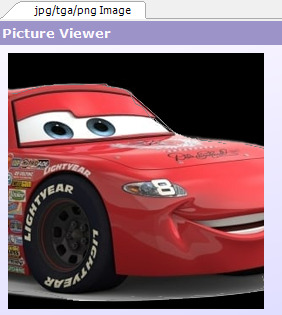
For awhile I wondered why this particular image was thrown in so randomly into not just this file, but almost every file in the March 2021 dump. But thanks to Linda’s providing that lovely VK link on her callout post against NoMoreSims2Patreon, I finally know the only person in this that had any ‘sentimentality’ regarding Mr Junior over here. (Yes, it’s not actually McQueen, which makes it all the more specific! I love it!)
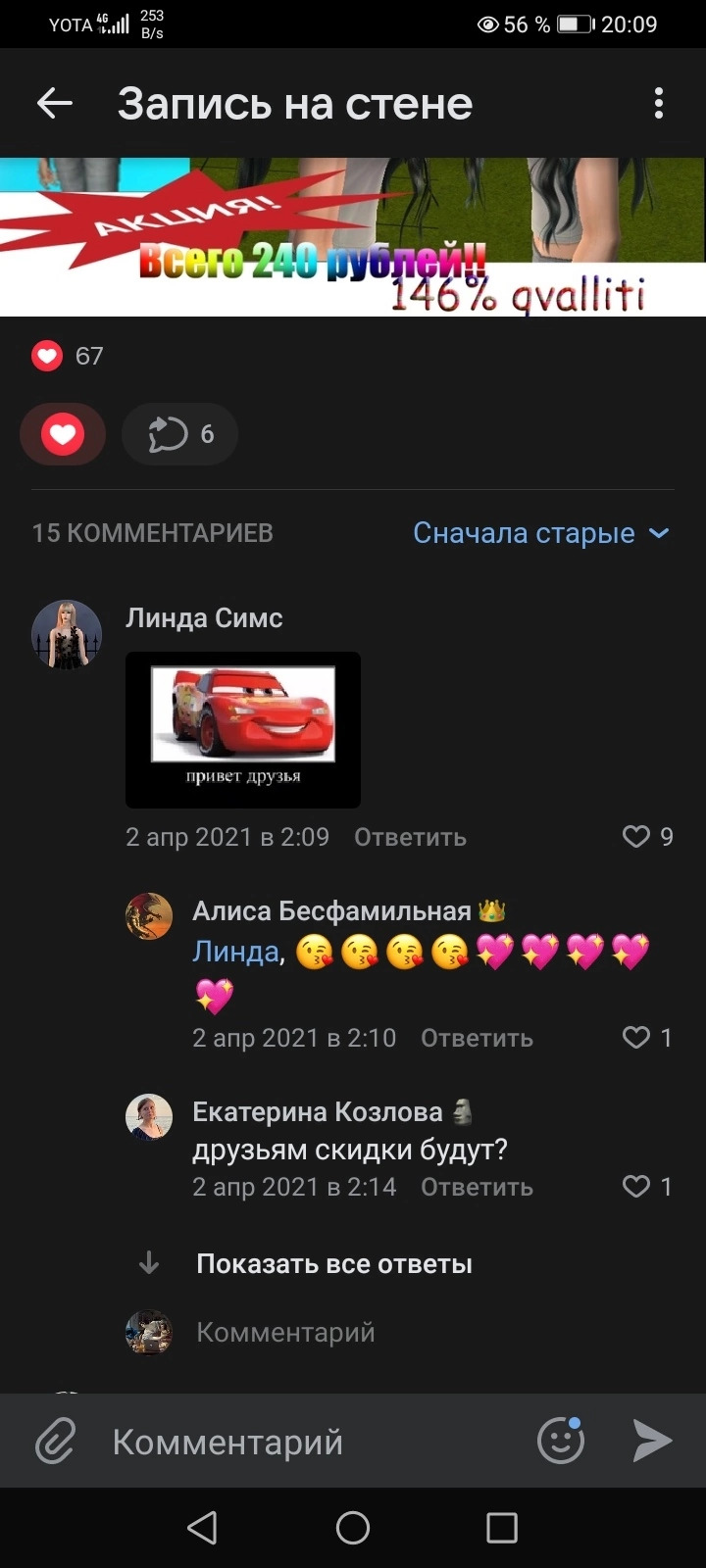
This was posted just 1 day after that lovely March 2021 dump finally released, on 1st April. No coincidence, I bet, that this Junior is being sent by the lovely lindasims2 herself! Photo provided by @honeymoonseason and also shared to me by multiple others :]
Yeah, Linda, what do you have to say to this…? Your favourite fake Lightning McQueen has finally exposed who actually placed him in this file, and only because you were kind enough to link us to your VK group <3
THE DATES
So, after this pretty incriminating discovery, I decided to backtrack and take a look at what Linda claimed in her callout post to NoMoreSims2Patreon:
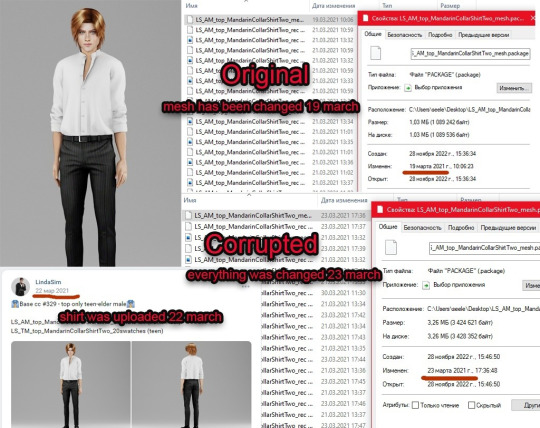
These files were apparently last edited on March 28, many days after Linda made a post announcing them. Which points to the leaker being the one to edit them, right?
Well…Linda, did you forget how you operate or something?


Linda uploaded these files on April 1st 2021, having ‘forgotten’ to upload them on March 31st. Credits go to @caramelsmiles12 and @honeymoonseason for the pics <3 Yeah, Linda, thanks for admitting your own guilt?
It’s impossible for any leaker to be able to edit files before they’re even released. To my understanding, Linda purposefully added those corrupt characters and NSFW defaults to her CC, as a sick April Fool’s prank on the people who download her leaked CC.

All of the files you see above, have had the hidden sim, PT 19 (also renamed some very bad slurs by Linda) slipped in. (Though #332 has been accidentally saved by me, lol). The top-only teen-elder male folder also contains the weird gigantoborkodoggo default. And they were all last edited a day before Linda even released the files to her subscribers.
THE EXPERIMENTS
@fireflowersims was kind enough to do some experiments with the corrupted files, to see what else we could find, as well as to dig deeper in them. I won’t state all of them here, but here are a few that stood out to me:

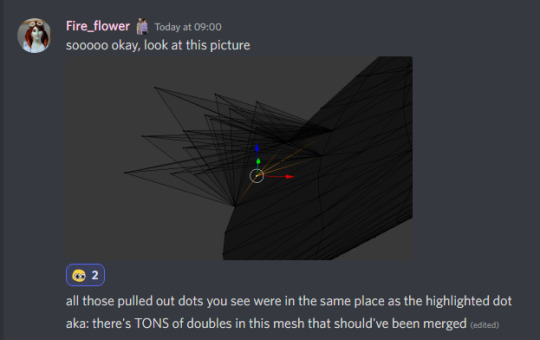

THE LOGIC
I can already hear Linda’s hardcore defendersand subscribers in my askbox (like @alicestrife and @sims2x10 <3) claiming that the pics have been edited, that somehow I have changed the story, etc. I have done nothing except look at the facts I have dug up or been shown. If you want proof, look at this post, it contains some stuff that may interest you and was found over a year ago. As well as the original files :]
I can already see that not being enough for some of you, so here’s the logic even if you don’t take the incriminating Junior (yeah, the fake Lightning McQueen) JPG, or the fact that the files were edited pre-release, into account.
Let’s look at the pros and cons to corrupting these files, for both Linda and her leakers.
PROS FOR LINDA: Gets to ‘expose’ the leaker that has been a thorn in her side all this time. Gets to prank the clueless people who download from her for April Fool’s. Gets more subscribers since people are desperate for ‘good’ content from her.
CONS FOR LINDA: Some people may accuse her, but of course, she always points them to her leakers. Because who else gets direct content from her? Only her hardcore patrons, who won’t turn against her.
PROS FOR LEAKERS: Uhh… maybe gets a kick out of seeing people get mad at Linda?
CONS FOR LEAKERS: People no longer trust them. They won’t download their content, which is how pirates survive in this community. Attitudes towards pirates have always been terrible in this community, especially from the paywallers themselves. Also, people will probably accuse them since they are the people who reupload CC.
Who do you think would have corrupted these files, even without the evidence shown above?
SUMMARY
Stolen meshes, illegally paywalled content, etc. was never enough for Lindasims2, clearly. No, she had one thorn in her side that she wanted to get rid of: NoMoreSims2Patreon, who continually shared her files FOR FREE to the public and meant she made much, much less money.
So, for one final April Fool’s joke of leaked content, she slipped in a very large, very corrupted surprise for anyone who downloaded from her leaker–and sat back and waited. A year later, @dystopianam stumbled across that hidden surprise and on spiraled this saga of discoveries by myself and many others.
However, Linda made a couple of mistakes. She assumed people would look at her response post and think, oh, surely it’s the leaker! Linda’s dates match up!
But thanks to Dale Earnhardt Jr. himself, a bunch of Simscorders and many others decided to research further. And found her lie. Thanks for having such love for a minor Cars 1 character, Linda!
I urge everyone to do their best to report Linda’s Tumblr account, Boosty, Patreon, etc. What she has done ON PURPOSE to destroy people’s games and frame others is NO JOKE. I am not sure if we can take legal action against this sort of ‘malware’ that she produced many years ago, but I know one thing.
A minimum of 2278 simmers have downloaded the reuploaded archive containing Linda’s special April Fool’s 2021 joke. 2278, not counting anyone who might’ve been shared these files through other links, downloaded them from friends, etc.
CHECK YOUR GAMES, guys! And for the love of all things holy, STOP SUPPORTING SIMS PAYWALLERS! ESPECIALLY THIEVES LIKE LINDA!
#lindasims2#s2cc#sims 2 cc#ts2 cc#important info#the lindasims research and experimentation#how do u tag these sorts of posts#sims 2 research#sims 2 alert#lindasims#fuck you linda#you can say what you want about the results of my research#but the root issue is YOU#YOU paywalled the content. you deal with the people whose games are fucked because of YOUR money-hungryness
247 notes
·
View notes
Text
Story of Our Life
A Harry Styles Imagine
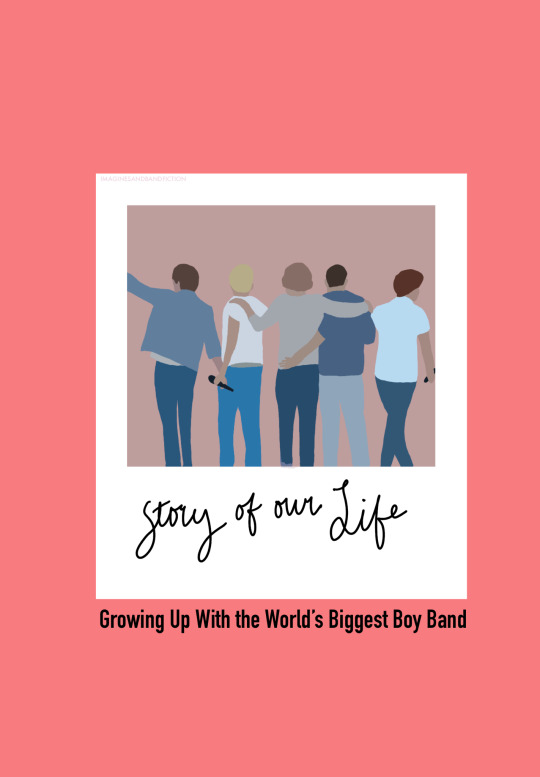
Pairing: Harry Styles x Reader
Word Count: 4.1k
Warnings: None
A/N: This is something a little different that was inspired by a dream I had where I was singing Story of My Life with 1D in a car... Also, I made some cover art on procreate plz don't judge my mediocre art skills lmao. Hope you like it!!!!!
Masterlist
Excerpts from
STORY OF OUR LIFE
by
Y/N Styles
To Louis, the best chauffeur I’ve ever had.
To Liam, who keeps us all sane. Steady on, mate.
To Zayn, who always offers a shoulder to cry on (and a cigarette).
To Niall, the king of late-night chats (and snacks).
To Harry, for everything, forever.
Introduction by Harry Styles
Before she was my wife, Y/N Styles was Y/N Y/L/N. We met in 2011, six months before we would be setting out on the Up All Night tour. Even though I had been on TV, in recording studios, and performed live on the X Factor Live Tour 2011, I was still just a shy kid from Holmes Chapel who couldn’t quite believe his luck. I think I spent that whole year in a state of disbelief, afraid that at any moment, someone would tell me that it was all a joke and I wasn’t very good at singing, actually. Every time I took a shower, I half-expected Ashton Kutcher to jump out at me from behind the shower curtain. Y/N, on the other hand, walked into the conference room at Columbia Records, sat down at the head of the table, folded her arms across her chest, and asked us each, individually, if we had read Harry Potter and the Deathly Hallows and, if so, how did we feel about it? Immediately, I knew that this girl was going to be someone special.
Her dad, Greg Y/L/N, was going to be our tour manager. When it was time for the label to put a team together, he was at the top of the list: a goofy dad with a daughter around our age who had toured with some of the biggest musicians of the 90s. He was the perfect choice for a bunch of kids who didn’t really know what they were doing: industry experience to make sure the day-to-day operations went smoothly, and the paternal instinct to protect us as best he could (we called him Papa Bear, which he pretended to hate, but we all knew he secretly loved it).
We grew up together, spent months on end traveling the world, learning algebra on private planes and sneaking out of hotel rooms to wander foreign cities in the middle of the night. Fast forward to today. While Y/N was pregnant with Willa, our second child, she spent the whole third trimester on bed rest. Eventually, she got so bored that she scrolled all the way back on iCloud. Our older daughter, Hazel, was fascinated by the pictures of me and the band, and Y/N spent hours recounting our days on tour. I told her that she should write a book, but she refused at first. We have enough money, she said. People will think I’m making a cash grab. I told her that was bollocks, but if she really felt that way, she could donate all the profits to charity. It’s perfect, really, I said. The 20-year anniversary of One Direction is coming up, and it would be cool to give the fans a peek behind the scenes. Really, there’s no one better than you, darling, because you know the real us. She agreed, but only if all five of us were okay with it, and if all of the proceeds could go to The Trevor Project. So really, it’s actually me you should be thanking for convincing her to do this in the first place.
Anyways, here it is. The Story of Our Life: Growing Up With the World’s Biggest Boy Band, written by my amazing wife, Y/N Styles.
Chapter 5
Out of all the One Direction boys, Louis was the first one to get his driver's license in America. He spent the few months leading up to the Where We Are tour with his girlfriend in California, and wanted to buy a fancy car to drive her around in. Hence, the license. So, when the tour made its way to North America, he somehow managed to convince my dad and the security team to let him drive us from the hotel to the venue a few times. Of course, the windows were tinted (and we were not allowed to open them), we were surrounded by a security detail, and there was always a bodyguard in the backseat, but it didn’t matter.
On the night of the second show in Detroit, we all piled into a tricked-out Toyota Sienna, the best minivan on the market in 2011. Louis and Liam sat up front, I was squished between Harry and Niall in the middle, and Zayn and the bodyguard sat in the way back. We had the radio blasting and were singing along to some absolute bangers, like Party Rock Anthem and Super Bass, when the first few notes of Story of My Life started playing. Louis groaned and reached over to change the station, but I leaned forwards and slapped his hand out of the way before he could, turning the volume up a few notches.
“Written in these walls are the stories that I can’t explain,” I sang along with Harry’s voice, turning to look at him with a mischievous smirk. He was mouthing along but bit his lip as soon as I caught him. Liam piped up with his part and I shook my head, laughing.
“Do you guys seriously only ever sing your parts?” I asked. Next to me, I felt Niall shrug.
“Feels wrong to sing someone else’s, even off stage,” he said, before chiming in on the background vocals as Zayn jumped in on his part.
“Well, you should do it anyway, just for fun.” Liam turns around and lifts his eyebrows in a silent challenge. Harry and Niall jumped in, and soon we were all belting out the words to every part.
When the final chorus came up, I turned to rest my head on Harry’s shoulder, singing his part back to him. He was usually the shameless one, but his cheeks were tinted pink and he stopped singing for a few seconds. His green eyes were wide, but they never once left my own. I felt his chest rise and fall in a deep, steadying breath before he began singing again.
From that moment on, Story of My Life was our song. Every time they performed it, he turned towards the side of the stage during the last chorus, where I sang along. On the rare occasions that I sat in the audience, his eyes always managed to find mine. We sang lines to each other all the time. Our favorite thing to do, much to everyone else’s dismay, was yell Zayn’s pre-chorus to each other from across a room.
“And I’ll be gone, gone, tonight,” one of us would start.
“The ground beneath my feet is open wide,” the other would respond.
“The way that I’ve been holding on too tight,” the first person would say, before we both shouted, “With nothing in betweeeeeeeen!” That line was always the loudest, and we always dragged out the last syllable until we couldn’t breathe anymore.
Chapter 9
When Harry’s solo album dropped, I was in class, taking my Algebra 101 final. My test-taking nerves were multiplied tenfold by the fact that I knew people were listening to it right now, and I wasn’t. We had kept in touch after One Direction broke up, mostly over text but occasionally, when he was in LA, he came to my house to have dinner with me and my Grandma (and Dad, if he was home).
I listened to it all the way through on the drive back home to Pasadena after I finished my exam, and as soon as I pulled into the driveway, I texted him.
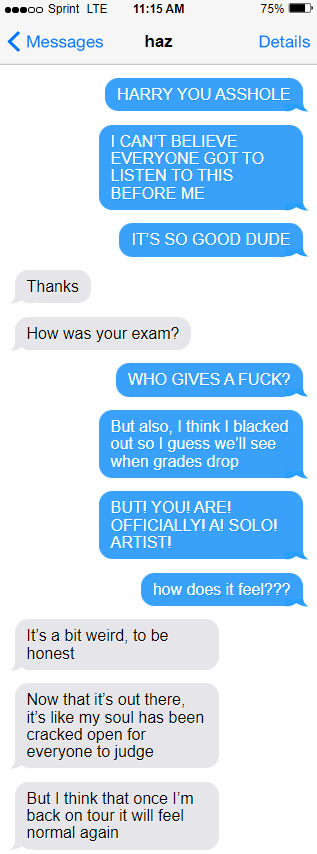
I signed up for a presale code, and refreshed my laptop continuously for five straight minutes in order to get tickets for his LA show. Harry was furious with me. When I texted him that I was officially coming to the show, he called me in the middle of a meeting with his tour team to yell at me. Something along the lines of, “I put you on the VIP list, you dumbass! And invites to the afterparty were just sent out yesterday!”
To be fair, I just wanted to support my friend, and to this day I still feel uncomfortable asking for free tickets from anyone when I have the means to pay for them. I think it’s all the guilt from five years of attending One Direction concerts for free. But anyways, that next fall, I found myself backstage at the Greek Theater with a VIP badge around my neck, feeling intense deja vu as security led me to Harry’s dressing room.
“Y/N!” He yelled as soon as the door opened. I had no time to react; I was nearly knocked over by the force of his hug. His mom and sister were there, too, and I was passed around for more hugs before settling next to Harry on the couch.
“So, how’s it going? How’s school?” he asked, leaning forward with his elbows on his knees. That’s one of the things I love most about Harry; no matter how long it’s been since he’s seen someone, he always picks back up like no time has passed. He is scary good at keeping up with what everyone else is doing, even when his own life
“Kicking my ass already and it’s only been three weeks,” I said with a chuckle. “But better than last year, that’s for sure!” Harry’s brows furrowed and he waited expectantly. “Did I not tell you that my original roommate was psycho?”
“No, I don’t think that’s come up before.” I pulled up a photo on my phone and handed it over to him without a word, and I don’t think I’ve ever seen his eyes wider than they were in that moment.

“Holy shit,” she said.
“I wanna see!” Gemma whined, leaning across the coffee table to snatch the phone from him. “Oh my god, Mum, look!” She handed the phone to Anne, who frowned down at it.
“This was your dorm?”
“For all of three days, yes,” you answered. “I’m not sure what creeped me out more, the life-sized cardboard cutout of Harry watching my every move, or the fact that she threatened to blackmail me if I didn’t introduce her to you.” Harry was doubled over with laughter with tears welling up in the corners of his eyes.
“What are the chances of you, of all people, rooming with a crazy One Direction fan in college?” he asked, struggling to breathe enough to support his vocal chords.
“The school investigated and they found an invoice for a private investigator on her computer in a folder with a bunch of my personal information and photos of me that looked like they were taken from behind bushes and trash cans. Apparently, she gave him that paparazzi photo from the week we were in London during On the Road Again and he was able to track me down.”
“He was able to figure out your identity from that photo?” I nodded, and Harry looked impressed, yet mildly disturbed. “She must’ve paid a fortune.” The photo in question features all five members of One Direction on their way into the O2 arena, and in the background, you can see the blurry back of my head as I slipped into the back door ahead of them.
When it was time for Harry to get ready, a security guard led Anne, Gemma, and I to the VIP section and we settled in for the show. He killed it on stage, and it was great to see him back in his element, joking with the fans between songs and waving to everyone he made eye contact with. He performed What Makes You Beautiful and the cheers were so loud, even in the small-theater setting, that I knew I would probably have trouble hearing tomorrow.
“Alright, now normally I’d go straight into Kiwi, but there’s someone special in the audience today and this next song means a lot to the both of us, and she was the one who told me to sing all of the parts even though it feels weird, I hope you’ll forgive me for making you wait a few more minutes,” he said with a smirk, knowing that no one was going to complain about an extra song. My smile widened and Anne wrapped an arm around me, squeezing my shoulder, to acknowledge how special this moment was about to be. Just like old times, Harry looked straight at me as the intro music started to play.
“Written in these walls are the stories that I can’t explain,” he began, and immediately tears started welling up behind my eyes. I joined in, leaning my head on Anne’s shoulder for support. When he got to the second pre-chorus, he yelled out “And I’ll be gone, gone, tonight!” and held out his mic for the audience to sing the next line, but I caught an almost-imperceptible wink as he smiled up at me and I knew that he could care less if anyone else chimed in.
“The fire beneath my feet is burning bright,” Anne, Gemma, and I screamed, hoping that we were loud enough for him to pick our voices out of the crowd.
He sang the next line, and so did the audience, but I kept my mouth shut and joined in on the last line. He dragged out “between” so long that he had to jump back in on “I take her home.” I was the only one still singing along with him at that point, and the audience let out confused laughter, looking back and forth trying to figure out why he wasn’t moving on yet.
Chapter 11
We’ve never talked about how we got together, and once the gossip magazines found out that I was the daughter of One Direction’s former tour manager, they just filled in the blanks themselves. I try not to read those things, but I do remember seeing a few headlines like “CHILDHOOD SWEETHEARTS RECONNECTED!” over that grainy paparazzi photo of us in Holmes Chapel before the Manchester Love on Tour stops. Others spun the fact that I was doing PR on the tour into a fake “HARRY STYLES KISSES EMPLOYEE” scandal, and it just spiraled out of control from there. But I’m getting ahead of myself.
When the pandemic hit, I was at home in Pasadena with my dad and grandma. We had no other “bubble” because my grandma was immunocompromised. Needless to say, I got very bored very quickly. It got to the point that I would cycle through the contacts on my phone, Facetiming everyone in alphabetical order by last name until someone picked up. Harry was one of the only people who answered every single time. We ended up calling each other almost every day, sometimes to chat, or just to have someone there, in the background, while we went about our days. He was with his band, working on what would eventually become Harry’s House, and I spent many days listening to them work through different lyric and melody combinations while curled up in my childhood bedroom with my work laptop. He even interrupted a Zoom meeting I was in, once, excited to play part of “Music for a Sushi Restaurant” for me.
I was working remotely for a PR firm, after graduating college in 2020, my options were limited and, in the end, the place only gave me an offer because they worked with Columbia Records and knew my dad. I mostly wrote copy about movies to be put on Wikipedia or IMDB, which was super boring, so Harry seriously saved my life by letting me listen in on his studio sessions, or to the audio of whatever show he was watching and his commentary.
By the time he was able to start prepping for Love on Tour, I was working at the firm’s office building on Sunset, just about ready to quit my job and sell foot pics online.
“Come on tour with me,” he said, (seemingly) impulsively, during one of our Facetime sessions in which he patiently listened to me complain about how Mark from accounting wouldn’t stop coming over to my desk to “chat” every hour on the hour.
“What?” I answered, laughing a little.
“Seriously, Y/N, it’ll be just like old times! We can race on the dolleys they use to bring the speakers in, and I’ll even let you win this time.” I rolled my eyes.
“It’s not really winning, then, is it?”
“Okay, fine, I won’t let you win. But I am serious, Y/N. You should join me on tour.”
“What am I supposed to do, just follow you around the world like some sad, desperate groupie?”
“I mean, you are a bit sad and desperate.” I flipped him off, to which he responded by cackling with laughter.
“I’m sad because my job sucks, and desperate to get away from Mark, not to get into your pants.”
“Well, you wouldn’t be my mistress, you’d be doing PR for the tour, obviously.” Harry’s cheeks flushed with the slightest hint of pink,
“Well, maybe you should have led with that!” I started laughing, too, and it took a while for either of us to be able to speak again.
“Okay, sorry, I’ll start over.” He took a deep breath to calm his giggles, but still couldn’t manage to keep a straight face. “Y/N Y/L/N, I would like to formally request that you join me as my PR Manager for Love on Tour. My publicist is about to give birth, like, any day now so she obviously can’t go gallivanting around the world. Really, you’d be doing me a favor, and who better than someone who already has my dressing room requests memorized since half of them are actually yours.”
“You still have the same dressing room requests?” I gave him a skeptical look.
“Old habits die hard.” He shrugged. “And even though I don’t drink Diet Coke, having it in the fridge makes it feel like you’re there with me.” The pink was now red and I bit my lip to keep myself from smiling too wide.
“Alright, Mr. Styles, you have a deal.”
Like he said, old habits die hard, so even though we were now adults and my dad wasn’t on tour with us, we still fell into our old routines. Back in the day, I was never allowed to be alone in a room with one of the boys, but we had our ways around it. Usually by walking through the hallways of the floor of the hotel everyone was staying on, checking in with the guards stationed at either side on every loop. So while we could have hung out in our rooms, more often than not, we walked through the hotel hallways in circles just like we used to.
The night before the Pittsburgh show, Harry showed up at my door at 10pm with a bag of sour gummy worms.
“It’s not Haribo, but it’s close enough,” he said with a shrug, flashing me his trademark “Harry Styles” grin. And just like that, we were off to wear a hole in the carpet, or so I thought. We hadn’t even made it through one full loop before he pulled me through a random door marked “Employees Only” and dragged me up three flights of stairs.
“Are you taking me somewhere private so you can murder me?” I asked as we trudged through the dirty stairwell.
“Something like that,” he answered. But when we reached the top, he opened another door and we were on the roof.
The view was gorgeous, the moon was bright and cast a cool glow on the Pittsburgh skyline. I turned to Harry with wide eyes.
“Scoped it out earlier,” he said with a sheepish smile on his lips. “Just thought we could use a change of scenery.”
“It’s perfect,” I said, reaching out to squeeze his hand in thanks. “As much as I love hotel hallways, this is better.”
We sat on the edge of the roof, dangling our legs over the top of the building next door, and passed the bag of gummy worms back and forth as we talked. We were out there for so long that my eyelids started to get heavy and our conversation slowed down. I leaned my head on his shoulder and he wrapped his arm around me, huddling closer for warmth (or so I thought).
“Wanna listen to some music?” He asked. I nodded and he pulled his Airpods out, sticking one in my ear and the other in his own.
Story of My Life started playing and my heart rate sped up, pulsing adrenaline through my body. Suddenly, I was wide awake and hyper aware of every place our bodies were touching (thighs, hips, my shoulder to his chest, his shoulder to my head, his arm on my bicep).
I lifted my head up and turned to look at him.
“Do you ever get sick of this song?” I asked. My voice was quiet because I wasn’t sure I actually wanted to know the answer.
“No,” he replied. His voice was low and raspy and it made my stomach flutter. I felt myself leaning in, unconsciously, as he continued. “It reminds me of you, and I could never get sick of you.”
He brought his free hand up to my face and rubbed his thumb in soft circles on my cheekbone, and his eyes flickered down to my lips. The distance between us closed as if we were replaying something that had already happened in slow motion. Eventually, I could just barely feel the soft brush of his lips against mine. My mouth fell open just a bit in anticipation of what was to come, but Harry paused.
“It’s you, Y/N,” he whispered.”It’s always been you.”
Feel free to cross my name out and write in your own, I won’t be mad. I get it; what really happened was better than any self-insert fanfiction.
Chapter 17
I’m going to keep most of the details of our wedding private, but I will tell you about our first dance, because it ties into a lot of the other stories that I’ve written about. If you haven’t noticed by now, Story of My Life is sort of the underlying theme of this book, and that’s because it’s been the underlying theme of my life, the soundtrack to my relationship with Harry.
After dinner, and some absolutely mental toasts, Harry and I were eager to get the party started. Even though he’s not the best dancer, I have never met anyone who dances with as much joy as Harry does, and I love getting pulled into his wild, spontaneous routines. But our first dance was different. The fairy lights surrounding the garden were twinkling in the moonlight, and Niall, Liam, Louis, and Zayn stood on the sidelines to sing, you guessed it, Story of My Life. We swayed in circles, gently, without trying to put on a show or impress anyone else. It was a beautiful, full circle moment, and the boys even dragged out “between” just a little bit to tease us.
Life is funny. One minute, you’re sixteen and screaming “The fire beneath my feet is burning bright,” at your best friend and you think that this is it, you will be touring the world with your friends forever, and the next you’re twenty-seven and in a wedding dress, leaving mascara stains on the shoulder of his suit. But I wouldn’t change a thing, because I think it was written in the walls all along.
#harry styles#harry styles imagine#harry styles fanfic#harry styles fanfiction#harry styles oneshot#harry styles imagines#imagine#imagines#one direction#one direction imagine#one direction imagines#one direction oneshot#harry styles x you#harry styles x reader#harry styles x y/n#harry styles fluff#imaginesandbandfiction#oneshot#documentary#tell all
185 notes
·
View notes
Text

Well, well, well...
If it isn't another secret round of "Kate is done being a royal but doesn't want to divorce William" in the Daily Mail today, courtesy of Rebecca English! [archive link]
Everyone should have realized back in late April that Kate was done with royaling when King Charles III awarded her the Companions of Honour. It wasn't an honour for a future queen to receive. Further, if she was actually suffering from such severe health problems where she needed to completely stop doing royal engagements, then the Order of St. John would have been far more fitting.
No instead, we saw Sophie wearing the Lotus Flower tiara during the Japanese state banquet in late June. Kate returned all the tiaras back to Queen Camilla this spring when she decided she was done, which is what made the Lotus Flower tiara available for Sophie to wear.
Kate being done with royaling, prior to the Japanese state visit, shouldn't have been a surprise as it was reported in early June that Kate “may never come back in the role that people saw her in before." But people still persist in the belief that it's because of her health. If it was just due to her health, then why would you tell people "never" when you're allegedly in the middle of a health battle? Unless she really isn't having a health battle, but a crisis between herself and her husband where the only way to assert herself is to go on a complete strike.
Cut to Tom Sykes' article last week [archive link], where it was noted that there was nothing in Kate's diary/schedule for the rest of the year.
Another source, a Buckingham Palace insider, said they understood there was no sense that Kate was expected to be back on duty for the traditionally busy period of royal engagements that kicks off in the first week of September and runs through to Christmas. The source said: “There is still nothing in her diary. My understanding is that people are going to have to get used to seeing a lot less of Kate. The priority for her now is going to be family and the children. The youngest of those kids, Louis, is only 6.
But Kate is healthy enough to grouse hunt!
It is thought the smaller Wales family are unlikely to travel this year to Tresco, a small island off the coast of Cornwall, where they have often spent summer holidays. However, The Daily Beast has been told that the couple are aiming to be in Balmoral either for the opening of the grouse-shooting season on Aug. 12 or shortly thereafter. William and Kate both shoot. [...] Another friend of the wider family told The Daily Beast that the royals were expected to descend on Balmoral en masse for the opening of the grouse-shooting season on Aug. 12, known colloquially as the “Glorious Twelfth.” The friend said: “Balmoral is basically a very fancy Victorian hunting lodge. That is what you do up there: You go out shooting, you fish, and you have lunch in the hut. It is an important ritual for Kate and William to take their children there for the Glorious Twelfth and that is the goal this year.”
Healthy enough to grouse hunt but not to do any other royal duties this year!
But now Becky English is coming with some extra details now that Harry & his wife are going to make public appearances starting tomorrow!
What most will not appreciate is that Catherine had actually been unwell for some time in the run up to her initial abdominal surgery in January (further details of which have not been made public yet by Kensington Palace). It was only after that ‘planned’ operation, of course, which left her in hospital for two weeks, that her cancer was discovered.
Oh, really? Is that why Kate went on an unprecedented string of pantsuits for thirteen straight appearances last fall? And if this detail of her being "unwell for some time in the run up" is actually true, then why spill that detail now instead of six months ago?
This means that far from hitting the ground running in the autumn, as some might have hoped after her glowing appearance at the weekend, it will continue to be a ‘slow build’ for the princess, taking on things as and when she feels physically - and, no doubt, mentally - strong enough. She is likely to continue to attend keynote national events, such as Remembrance Sunday.
She's already only attended keynote national events, such as Trooping the Colour. I'm sure Wimbledon will always be classified as a "keynote national event" in Kate's diary.
But it's awfully convenient that this slow roll of Kate not being in the public eye for the long term keeps coming out. Adjuvant therapy, aka Kate's "preventative chemotherapy" is usually only 3 to 6 months. Yet Kate's treatment might allegedly extend into next year, if we're to believe Becky English! Did Kate's "preventative chemo" not start in late February, as they previously told us?!
Another well-placed source confirms this, adding: ‘Her continuing treatment is the key issue for her personally, and for them all as a family. ‘For anyone there is a lot of physical recovery after treatment finishes. It’s not like flipping a switch.’
Usually recovery from adjuvant therapy is only a few weeks. Except for Kate!
And when the Princess is ready to return to a more public life, she will. [archive link]

#well well well#well there's your problem#my gif#british royal family#“Celebrity” Catherine Middleton#kate middleton#Catherine The Princess of Wales#Daily Mail#rebecca english#Wales fandom ARMAGEDDON#Wales fans are CHUMPS#The Will & Kate Cult#crazy cambridge stans#Wales Wailers#King Charles III#duchess sophie#tom sykes#tiaras#pr games#strategery#lies lies lies#cancer schmancer
9 notes
·
View notes
Text
As we approach the one-year mark since the horrific events of Oct. 7, 2023, it’s time to recognize that the methods attempted so far to gain the release of the remaining 101 hostages held in the Gaza Strip—including four American citizens—aren’t working. President Biden has failed to get Israel and Hamas to accept a ceasefire and a prisoner exchange despite months of prodding. Israeli rescue attempts have had only limited success. Israel said on Sunday that during a recent military operation, its troops discovered six hostages who had been killed by their captors, including Hersh Goldberg-Polin, an American Israeli who had been one of the faces of the hostage ordeal—and whose parents spoke at the Democratic National Convention last month. Goldberg-Polin and the others did not have to die.
Two things should be clear to anyone paying attention: First, Hamas and its senior leader in the enclave, Yahya Sinwar, are responsible for the ongoing suffering of the hostages in Gaza; and second, Israeli Prime Minister Benjamin Netanyahu has the power to secure their release but has chosen again and again not to do so.
Since December, there has been a proposal on the table to exchange hostages with Palestinian prisoners in Israeli custody at a ratio that favors Hamas. It is predicated on a cease-fire and a path to a diplomatic settlement of the war. It is the only formula that could secure the return of all hostages from Gaza.
Sinwar will not agree to changes in the basic outlines of the deal. Counter to Netanyahu’s claims, military pressure does not work on him. In warfare, it is important to understand your adversary. For Sinwar, the rising death toll in Gaza with all its attendant pain actually advances his core interest: It increases the delegitimization of Israel internationally. And while Sinwar is clearly going to great lengths to protect his own life, he would rather die than give up hostages without securing an end to the war.
Netanyahu, for his part, is not genuinely interested in a hostage deal, as it endangers his political survival. As long as there are hostages in Gaza, he has a justification to continue the war. And as long as the war continues, he can push off demands for a commission of inquiry, an early election, and a broader political reckoning. Netanyahu presided over the single largest one-day loss of civilian Jewish lives since the Holocaust, and his only way to survive politically is by perpetuating the war. While Netanyahu pays lip service to the hostages and to Biden’s efforts on their behalf, he is actively sabotaging any chance of a deal.
He has done so throughout the negotiating process by repeatedly introducing new demands. The latest example is his insistence on maintaining Israeli control of the border between Gaza and Egypt, which Israel calls the Philadelphi Corridor. Netanyahu said that holding the corridor is necessary to prevent Hamas from rearming. But Israel didn’t bother capturing Philadelphi until nine months into the war. And Israel’s own security chiefs believe it’s possible to block the flow of arms from Egypt without maintaining a troop presence there.
Netanyahu has also ordered provocative military actions at several junctures when it appeared that the negotiations might be advancing. In early January, when the three-stage hostage deal was gaining steam, Netanyahu authorized the assassination of Hamas deputy leader Saleh al-Arouri in Beirut—halting the talks. In early April, just when the United States, Egypt, and Qatar made a breakthrough on the hostage deal, an Israeli attack in northern Gaza killed three sons and four grandchildren of Hamas political chief Ismail Haniyeh. Negotiations stalled. The pattern is unmistakable.
Multiple times over the past few months, Netanyahu has committed himself to a deal in private meetings with Biden or members of his team, only to move the goal posts publicly.
This happened in May, when Biden spoke publicly about his agreement with Netanyahu, and again just last week, following Netanyahu’s three-hour meeting with U.S. Secretary of State Antony Blinken.
I’ve been involved in hostage negotiations for a long time, and so I can tell you: When there are gaps between the sides and you want negotiations to succeed, you emphasize the common ground in your public remarks. If you want the negotiations to fail, you speak publicly about the gaps. It’s hard to ignore the fact that Netanyahu only ever talks about the gaps.
From the outside, this certainly feels like an impasse. But there is another way.
Biden should set aside, for now, the effort to reach a comprehensive hostage deal and focus on bringing home the four Americans held in Gaza (four other Americans were abducted on Oct. 7 but have since been confirmed dead). He should do it quickly, before they too are killed as a result of Netanyahu’s self-serving policies. Protecting the safety of American citizens is the first order of responsibility for any U.S. president. In trying for a more limited deal, Biden would be honoring that mandate—but he might also end up breaking the impasse and nudging the sides toward a broader deal.
To put the Israeli hostages to the side for now and aim for a much smaller agreement would certainly be painful. I have maintained regular contact with the families of many of the hostages—they have endured the worst kind of suffering imaginable over the past year. As an Israeli citizen, I share their anguish—and I’m devastated by the discovery of the six dead hostages.
It would also be complicated.
The United States designates Hamas as a terrorist group and has a no-concessions policy when it comes to American hostages. Any negotiation would have to be indirect. But the current talks are already indirect—mediated by Qatar and Egypt. Building a communication channel is often the hardest part of the negotiation. In this case, it already exists.
Regarding the terms of a deal, the White House might wonder what it could offer Hamas in return for the Americans. After all, the United States cannot stop the war, nor does it have Hamas prisoners to release. This is where emotional intelligence would be key. This type of deal would not be about what the United States can offer Hamas—though humanitarian aid to Palestinians in Gaza could be included in the package. Instead, it would be about what strategic gains Hamas stands to make by doing a deal with the United States.
From Hamas’s perspective, an agreement would potentially stoke tensions between Israel and the United States—thereby advancing the group’s interests. And it would reveal Netanyahu as an obstructionist. All four Americans held in Gaza are also Israeli citizens. Their release would reflect badly on Netanyahu, underscoring that Biden was willing to do more for Israelis than their own leader.
Of course, the initiative could be framed by Biden’s political opponents as a betrayal of Israel at a sensitive moment, ahead of the U.S. presidential election in November. But the administration could make a strong case regarding its responsibility to protect the lives of U.S. citizens after almost a year of diplomacy. Or it could wait till after the election, when the lame-duck period makes the issue moot.
The most important outcome of such a deal would be the release itself—four people who have endured excruciating captivity for almost a year would be returned to their families. But an agreement—or even just the credible prospect of one—might just force Netanyahu to accept the larger hostage-deal framework.
To put it simply, it might be politically infeasible for Netanyahu to watch from the sidelines as Biden bypasses him and secures the release of hostages. The pressure from the Israeli street would be immense.
Biden has been a friend to Israel for his entire political career. A public display of tension and disagreement would be out of character for him. But a separate deal to bring home U.S. hostages would not rupture ties with Israel. Instead, it would reassert that American interests cannot be subordinated to those of a foreign power, even a close ally.
13 notes
·
View notes
Text
Right. Again, not intending this blog to offer advice on the regular but I think a bit of basic analysis guidance is on theme. So:
If a text does not target its criticisms towards the profit motive and private ownership of the means of production, it is not meaningfully critiquing capitalism.
Capitalism is not 'there are rich and poor' or 'greed is bad', or even 'money motivates people to act'. These existed prior to the capitalistic revolution and could very well endure under any successor systems. A text that deals with them alone -- without targeting the way the pursuit of profit *specifically* leads to distorted social priorities (like running healthcare as if it should generate more money than is put in) and how this manifests when things everyone on the planet needs are controlled by individuals -- is not making an effective argument against the economic arrangement currently buggering us all six ways to Sunday.
This is especially important to bear in mind if dire consequences are presented as a result of 'human greed', because doing so abstracts the problem away from its technical causes, which is one of the key ways capitalism diverts attention from its flaws. If the issue is merely people being 'greedy', then we just need to operate with more checks and balances. No need to tackle the core concept of a system geared to maximise profit over everything else . In fact, maybe capitalism is simply an extension of human nature and therefore *can't* be changed. Isn't it comforting, to know this is just what we're like?
(Urgh, what's the keyboard equivalent of washing your mouth out?)
A story isn't doing anything wrong if it does not concern itself with capitalism as a system. Heck, there's not anything wrong with grappling with the question of greed in general, because that is indeed something we need to grapple with: what does it mean, how does it work, how can we best mitigate it and the other worst aspects of ourselves? Many stories do exactly this while clothed in the aesthetics of capitalism and its many, many horrible outcomes.
But aesthetics are not an argument. And getting mad about social inequality and wars ignited by the whims of the rich is not the same as zeroing in on capitalism as the major cause or catalyst. It is in fact quite common to hate all the consequences of private ownership and the profit motive while still believing those things in and of themselves are neutral, normal ways of organising the world. This filters into fiction, producing ultimately toothless attacks on 'big business' or 'corporate greed' or even just the insidious idea that if we put the right people in charge of the system, everything will be OK.
(I cannot think of a better example than the first Iron Man movie, an almost pathologically deflective piece of cinema.)
Take the time to consciously read fiction through a capitalistic lens! Pick apart how it reflects the world at the point the story was written! Ask how the author approaches the issues they raise!
At the same time, avoid crediting them with an argument they aren't making. Identify what they actually say above all else and check it against the definition of the things they evoke. Only then will you be on solid ground to state whether or not they are attacking capitalism.
To beat a favourite drum, words have meaning. That matters quite a lot when talking about the meaning of a story.
This has been me vague-posting at the entire Gundam fandom. You're generally lovely but I do occasionally feel the strong urge to start pelting you with dictionaries, and burying this point in an essay about McGillis Fareed was apparently not enough to sate my need to grumble about it (c.f. section A digression into narratives about capitalism).
Thank you for your time. I shall be standing by the position that Iron-Blooded Orphans is the only solid critique of capitalism the franchise has produced (as a subset of exploring exploitation in general) until further notice.
#grumping#gundam#capitalism#writing#reading#boy did I get up on the wrong side of bed today#it just bugs me#especially since this is a franchise geared to sell toys#that has often had a fractious relationship with that function#being able to pick apart what the text is saying becomes quite significant in that context#you know?#the main point is generally applicable advice but I have to be honest about why I'm writing the post
7 notes
·
View notes
Text
Cancelled Missions: NASA's October 1977 Space Shuttle Flight Itinerary
"Soon after President Richard Nixon gave his blessing to the Space Shuttle Program on January 5, 1972, NASA scheduled its first orbital flight for 1977, then for March 1978. By early 1975, the date had slipped to March 1979. Funding shortfalls were to blame, as were the daunting engineering challenges of developing the world's first reusable orbital spaceship based on 1970s technology. The schedule slip was actually worse than NASA let on: as early as January 32, 1975, an internal NASA document (marked 'sensitive') gave a '90% probability date' for the first Shuttle launch of December 1979.
In October 1977, Chester Lee, director of Space Transportation System (STS) Operations at NASA Headquarters, distributed the first edition of the STS Flight Assignment Baseline, a launch schedule and payload manifest for the first 16 operational Shuttle missions. The document was in keeping with NASA's stated philosophy that reusable Shuttle Orbiters would fly on-time and often, like a fleet of cargo airplanes. The STS Utilization and Operations Office at NASA's Johnson Space Center (JSC) in Houston had prepared the document, which was meant to be revised quarterly as new customers chose the Space Shuttle as their cheap and reliable ride to space.
The JSC planners assumed that six Orbital Flight Test (OFT) missions would precede the first operational Shuttle flight. The OFT flights would see two-man crews (Commander and Pilot) put Orbiter Vehicle 102 (OV-102) through its paces in low-Earth orbit. The planners did not include the OFT schedule in their document, but the May 30, 1980 launch date for their first operational Shuttle mission suggests that they based their flight schedule on the March 1979 first OFT launch date.
Thirteen of the 16 operational flights would use OV-102 and three would use OV-101. NASA would christen OV-102 Columbia in February 1979, shortly before it rolled out of the Rockwell International plant in Palmdale, California.
As for OV-101, its name was changed from Constitution to Enterprise in mid-1976 at the insistence of Star Trek fans. Enterprise flew in Approach and Landing Test (ALT) flights at Edwards Air Force Base in California beginning on February 15, 1977. ALT flights, which saw the Orbiter carried by and dropped from a modified 747, ended soon after the NASA JSC planners released their document.
The first operational Space Shuttle mission, Flight 7 (May 30 - June 3, 1980), would see Columbia climb to a 225-nautical-mile (n-mi) orbit inclined 28.5° relative to Earth's equator (unless otherwise stated, all orbits are inclined at 28.5°, the latitude of Kennedy Space Center in Florida). The delta-winged Orbiter would carry a three-person crew in its two-deck crew compartment and the bus-sized Long Duration Exposure Facility (LDEF) in its 15-foot-wide, 60-foot-long payload bay.
Columbia would also carry a 'payload of opportunity' - that is, an unspecified payload. The presence of a payload of opportunity meant that the flight had available excess payload weight capacity. Payload mass up would total 27,925 pounds. Payload mass down after the Remote Manipulator System (RMS) arm hoisted LDEF out of Columbia's payload bay and released it into orbit would total 9080 pounds.

A page from the STS Flight Assignment Baseline document of October 1977 shows payloads and other features of the first five operational Space Shuttle missions plus Flight 12/Flight 12 Alternate
During Flight 8 (July 1-3, 1980), Columbia would orbit 160 n mi above the Earth. Three astronauts would release two satellites and their solid-propellant rocket stages: Tracking and Data Relay Satellite-A (TDRS-A) with a two-stage Interim Upper Stage (IUS) and the Satellite Business Systems-A (SBS-A) commercial communications satellite on a Spinning Solid Upper Stage-Delta-class (SSUS-D).
Prior to release, the crew would spin the SBS-A satellite about its long axis on a turntable to create gyroscopic stability and raise TDRS-A on a tilt-table. After release, their respective solid-propellant stages would propel them to their assigned slots in geostationary orbit (GEO), 19,323 n mi above the equator. Payload mass up would total 51,243 pounds; mass down, 8912 pounds, most of which would comprise reusable restraint and deployment hardware for the satellites.
The TDRS system, which would include three operational satellites and an orbiting spare, was meant to trim costs and improve communications coverage by replacing most of the ground-based Manned Space Flight Network (MSFN). Previous U.S. piloted missions had relied on MSFN ground stations to relay communications to and from the Mission Control Center (MCC) in Houston. Because spacecraft in low-Earth orbit could remain in range of a given ground station for only a few minutes at a time, astronauts were frequently out of contact with the MCC.
On Flight 9 (August 1-6, 1980), Columbia would climb to a 160-n-mi orbit. Three astronauts would deploy GOES-D, a National Oceanic and Atmospheric Administration (NOAA) weather satellite, and Anik-C/1, a Canadian communications satellite. Before release, the crew would raise the NOAA satellite and its SSUS-Atlas-class (SSUS-A) rocket stage on the tilt-table and spin up the Anik-C/1-SSUS-D combination on the turntable. In addition to the two named satellites, NASA JSC planners reckoned that Columbia could carry a 14,000-pound payload of opportunity. Payload mass up would total 36,017 pounds; mass down, 21,116 pounds.
Following Flight 9, NASA would withdraw Columbia from service for 12 weeks to permit conversion from OFT configuration to operational configuration. The JSC planners explained that the conversion would be deferred until after Flight 9 to ensure an on-time first operational flight and to save time by combining it with Columbia's preparations for the first Spacelab mission on Flight 11. The switch from OFT to operational configuration would entail removal of Development Flight Instrumentation (sensors for monitoring Orbiter systems and performance); replacement of Commander and Pilot ejection seats on the crew compartment upper deck (the flight deck) with fixed seats; power system upgrades; and installation of an airlock on the crew compartment lower deck (the mid-deck).
Flight 10 (November 14-16, 1980) would be a near-copy of Flight 8. A three-person Columbia crew would deploy TDRS-B/IUS and SBS-B/SSUS-D into a 160-n-mi-high orbit. The rocket stages would then boost the satellites to GEO. Cargo mass up would total 53,744 pounds; mass down, 11,443 pounds.
Flight 11 (December 18-25, 1980) would see the orbital debut of Spacelab. Columbia would orbit Earth 160 n mi high at 57° of inclination. NASA and the multinational European Space Research Organization (ESRO) agreed in August 1973 that Europe should develop and manufacture Spacelab pressurized modules and unpressurized pallets for use in the Space Shuttle Program. Initially dubbed the 'sortie lab,' Spacelab would operate only in the Orbiter payload bay; it was not intended as an independent space station, though many hoped that it would help to demonstrate that an Earth-orbiting station could be useful.
ESRO merged with the European Launcher Development Organization in 1975 to form the European Space Agency (ESA). Columbia's five-person crew for Flight 11 would probably include scientists and at least one astronaut from an ESA member country.
Flight 12 (January 30 - February 1, 1981), a near-copy of Flights 8 and 10, would see Columbia's three-person crew deploy TDRS-C/IUS and Anik-C/2/SSUS-D into 160-n-mi-high orbit. Payload mass up would total 53,744 pounds; mass down, 11,443 pounds.
JSC planners inserted an optional 'Flight 12 Alternate' (January 30 - February 4, 1981) into their schedule which, if flown, would replace Flight 12. Columbia would orbit 160 n mi above the Earth. Its three-person crew would deploy Anik-C/2 on a SSUS-D stage. The mission's main purpose, however, would be to create a backup launch opportunity for an Intelsat V-class satellite already scheduled for launch on a U.S. Atlas-Centaur or European Ariane I rocket. An SSUS-A stage would boost the Intelsat V from Shuttle orbit to GEO.
NASA JSC assumed that, besides the satellites, stages, and their support hardware, Columbia would for Flight 12 Alternate tote an attached payload of opportunity that would need to operate in space for five days to provide useful data (hence the mission's planned duration). Payload mass up would total 37,067 pounds; mass down, 17,347 pounds.

Space Shuttle Flights 13 through 18 would include the first orbital mission of the OV-101 Enterprise (Flight 17), during which astronauts would retrieve the LDEF payload deployed during Flight 7.
Flight 13 (March 3-8, 1981) would see three astronauts on board Columbia release NOAA's GOES-E satellite attached to an SSUS-D stage into a 160-n-mi-high orbit. OV-102 would have room for two payloads of opportunity: one attached at the front of the payload bay and one deployed from a turntable aft of the GOES-E/SSUS-D combination. Payload mass up would total 38,549 pounds; mass down, 23,647 pounds.
Flight 14 would last 12 days, making it the longest described in the STS Flight Assignment Baseline document. Scheduled for launch on April 7, 1981, it would carry a 'train' of four unpressurized Spacelab experiment pallets and an 'Igloo,' a small pressurized compartment for pallet support equipment. The Igloo, though pressurized, would not be accessible to the five-person crew. OV-102 would orbit 225 n mi high at an inclination of 57°. Mass up would total 31,833 pounds; mass down, 28,450 pounds.
Flight 15 (May 13-15, 1981) would be a near-copy of Flights 8, 10, and 12. OV-102 would transport to orbit a payload totaling 53,744 pounds; payload mass down would total 11,443 pounds. The JSC planners noted the possibility that none of the potential payloads for Flight 15 — TDRS-D and SBS-C or Anik-C/3 — would need to be launched as early as May 1981. TDRS-D was meant as an orbiting spare; if the first three TDRS operated as planned, its launch could be postponed. Likewise, SBS-C and Anik-C/3 were each a backup for the previously launched satellites in their series.
Flight 16 (June 16-23, 1981) would be a five-person Spacelab pressurized module flight aboard OV-102 in 160-n-mi-high orbit. Payloads of opportunity totaling about 18,000 pounds might accompany the Spacelab module; for planning purposes, a satellite and SSUS-D on a turntable behind the module was assumed. Payload mass up would total 35,676 pounds; mass down, 27,995 pounds.
Flight 17, scheduled for July 16-20, 1981, would see the space debut of Enterprise and the retrieval of the LDEF released during Flight 7. OV-101 would climb to a roughly 200-n-mi-high orbit (LDEF's altitude after 13.5 months of orbital decay would determine the mission's precise altitude).
Before rendezvous with LDEF, Flight 17's three-man crew would release an Intelsat V/SSUS-A and a satellite payload of opportunity. After the satellites were sent on their way, the astronauts would pilot Enterprise to a rendezvous with LDEF, snare it with the RMS, and secure it in the payload bay. Mass up would total 26,564 pounds; mass down, 26,369 pounds.
For Flight 18 (July 29-August 5, 1981), Columbia would carry to a 160-n-mi-high orbit a Spacelab pallet dedicated to materials processing in the vacuum and microgravity of space. The three-person flight might also include the first acknowledged Department of Defense (DOD) payload of the Space Shuttle Program, a U.S. Air Force pallet designated STP-P80-1. JSC called the payload 'Planned' rather than 'Firm' and noted somewhat cryptically that it was the Teal Ruby experiment 'accommodated from OFT [Orbital Flight Test].'
The presence of the Earth-directed Teal Ruby sensor payload would account for Flight 18's planned 57° orbital inclination, which would take it over most of Earth's densely populated areas. Payload mass up might total 32,548 pounds; mass down, 23,827 pounds.

Space Shuttle Flights 20 through 23 would include the first mission to make use of an OMS kit to increase its orbital altitude (Flight 21), the first European Space Agency-sponsored Spacelab mission (Flight 22), and the launch of the Jupiter Orbiter and Probe spacecraft (Flight 23)
Flight 19 (September 2-9, 1981) would see five Spacelab experiment pallets fill Columbia's payload bay. Five astronauts would operate the experiments, which would emphasize physics and astronomy. The Orbiter would circle Earth in a 216-n-mi-high orbit. Payload mass up would total 29,214 pounds; mass down, 27,522 pounds.
Flight 20 (September 30-October 6, 1981), the second Enterprise mission, would see five astronauts conduct life science and astronomy experiments in a 216-n-mi-high orbit using a Spacelab pressurized module and an unpressurized pallet. JSC planners acknowledged that the mission's down payload mass (34,248 pounds) might be 'excessive,' but noted that their estimate was 'based on preliminary payload data.' Mass up would total 37,065 pounds.
On Flight 21, scheduled for launch on October 14, 1981, Columbia would carry the first Orbital Maneuvering System (OMS) Kit at the aft end of its payload bay. The OMS Kit would carry enough supplemental propellants for the Orbiter's twin rear-mounted OMS engines to perform a velocity change of 500 feet per second. This would enable OV-102 to rendezvous with and retrieve the Solar Maximum Mission (SMM) satellite in a 300-n-mi-high orbit.
Three astronauts would fly the five-day mission, which would attain the highest orbital altitude of any flight in the STS Flight Assignment Baseline document. JSC planners noted that the Multi-mission Modular Spacecraft (MMS) support hardware meant to carry SMM back to Earth could also transport an MMS-type satellite into orbit. Payload mass up would total 37,145 pounds; mass down, 23,433 pounds.
On Flight 22 (November 25 - December 2, 1981), Enterprise might carry an ESA-sponsored Spacelab mission with a five-person crew, a pressurized lab module, and a pallet to a 155-to-177-n-mi orbit inclined at 57°. Payload mass up might total 34,031 pounds; mass down, 32,339 pounds.
During Flight 23 (January 5-6, 1982), the last described in the STS Flight Assignment Baseline document, three astronauts would deploy into a 150-to-160-n-mi-high orbit the Jupiter Orbiter and Probe (JOP) spacecraft on a stack of three IUSs. President Jimmy Carter had requested new-start funds for JOP in his Fiscal Year 1978 NASA budget, which had taken effect on October 1, 1977. Because JOP was so new when they prepared their document, JSC planners declined to estimate up/down payload masses.
Flight 23 formed an anchor point for the Shuttle schedule because JOP had a launch window dictated by the movements of the planets. If the automated explorer did not leave for Jupiter between January 2 and 12, 1982, it would mean a 13-month delay while Earth and Jupiter moved into position for another launch attempt.
Almost nothing in the October 1977 STS Flight Assignment Baseline document occurred as planned. It was not even updated quarterly; no update had been issued as of mid-November 1978, by which time the target launch dates for the first Space Shuttle orbital mission and the first operational Shuttle flight had slipped officially to September 28, 1979 and February 27, 1981, respectively.

The Space Shuttle Orbiter Columbia lifts off at the start of STS-1.
The first Shuttle flight, designated STS-1, did not in fact lift off until April 12, 1981. As in the STS Flight Assignment Baseline document, OV-102 Columbia performed the OFT missions; OFT concluded, however, after only four flights. After the seven-day STS-4 mission (June 27 - July 4, 1982), President Ronald Reagan declared the Shuttle operational.
The first operational flight, also using Columbia, was STS-5 (November 11-16, 1982). The mission launched SBS-3 and Anik-C/3; because of Shuttle delays, the other SBS and Anik-C satellites planned for Shuttle launch had already reached space atop expendable rockets.
To the chagrin of many Star Trek fans, Enterprise never reached space. NASA decided that it would be less costly to convert Structural Test Article-099 into a flight-worthy Orbiter than to refit Enterprise for spaceflight after the ALT series. OV-099, christened Challenger, first reached space on mission STS-6 (April 4-9, 1983), which saw deployment of the first TDRS satellite.
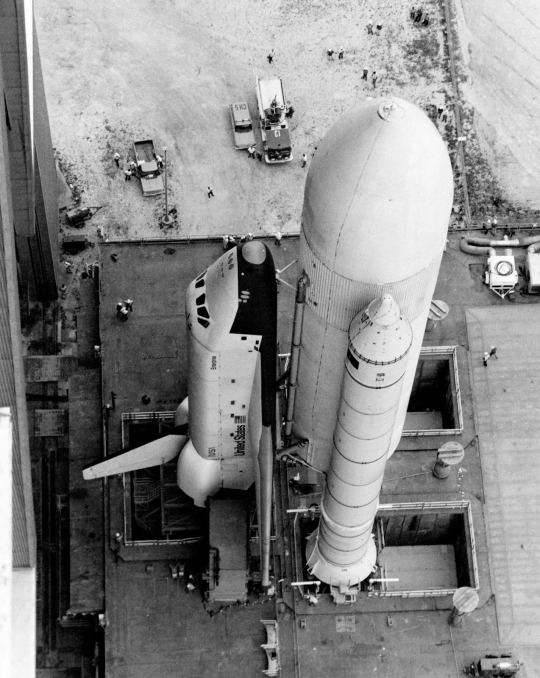
NASA put OV-101 Enterprise to work in a variety of tests and rehearsals (such as the 'fit check' shown in the image above), but did not convert it into a spaceflight-worthy Orbiter.
The voluminous Spacelab pressurized module first reached orbit on board Columbia on mission STS-9 (November 28- December 8,1983). The 10-day Spacelab 1 mission included ESA researcher Ulf Merbold and NASA scientist-astronauts Owen Garriott and Robert Parker. Garriott, selected to be an astronaut in 1965, had flown for 59 days on board the Skylab space station in 1973. Parker had been selected in 1967, but STS-9 was his first spaceflight.
The 21,500-pound LDEF reached Earth orbit on board Challenger on STS-41C, the 11th Space Shuttle mission (April 6-13, 1984). During the same mission, astronauts captured, repaired, and released the SMM satellite, which had reached orbit on 14 February 1980 and malfunctioned in January 1981. Challenger reached SMM without an OMS kit; in fact, no OMS kit ever reached space.
STS Flight Assignment Baseline document assumed that 22 Shuttle flights (six OFT and 16 operational) would occur before January 1982. In fact, the 22nd Shuttle flight did not begin until October 1985, when Challenger carried eight astronauts and the West German Spacelab D1 into space (STS-61A, October 30 - November 6, 1985). Three months later (28 January 1986), Challenger was destroyed at the start of STS-51L, the Shuttle Program's 25th mission.
In addition to seven astronauts — NASA's first in-flight fatalities — Challenger took with it TDRS-B, NASA's second TDRS satellite. The Shuttle would not fly again until September 1988 (STS-26, September 29 - October 3, 1988). On that mission, OV-103 Discovery deployed TDRS-C. The TDRS system would not include the three satellites necessary for global coverage until TDRS-D reached orbit on board Discovery on mission STS-29 (13-18 March 1989).
Following the Challenger accident, NASA abandoned — though not without some resistance — the pretense that it operated a fleet of cargo planes. The space agency had at one time aimed for 60 Shuttle flights per year; between 1988 and 2003, the Shuttle Program managed about six per year. The most flights the Shuttle fleet accomplished in a year was nine in 1985.
Shuttle delays meant that JOP, renamed Galileo, missed its early January 1982 launch window. It was eventually rescheduled for May 1986, but the Challenger accident intervened. Galileo finally left Earth orbit on 18 October 1989 following deployment from OV-104 Atlantis during STS-34 (October 18-23, 1989).
Between the time JOP/Galileo received its first funding and the Challenger explosion, NASA, the White House, and Congress had sparred over how the Jupiter spacecraft would depart Earth orbit. Eventually, they settled on the powerful liquid-propellant Centaur-G' rocket stage.
Citing new concern for safety following Challenger, NASA canceled Centaur G'. Galileo had to rely on the less-powerful IUS, which meant that it could not travel directly to Jupiter; it had instead to perform gravity-assist flybys of Venus and Earth to reach its exploration target. Galileo did not reach the Jupiter system until December 1995.
LDEF had been scheduled for retrieval in March 1985, less than a year after deployment, but flight delays and the Challenger accident postponed its return to Earth by nearly six years. On mission STS-32 (January 9-20, 1990), astronauts on board Columbia retrieved LDEF, the orbit of which had decayed to 178 n mi. LDEF remains the largest object ever retrieved in space and returned to Earth.
During reentry at the end of mission STS-107 (16 January-1 February 2003), Columbia broke apart over northeast Texas, killing its international crew of seven astronauts. This precipitated cancellation of the Space Shuttle Program by President George W. Bush, who announced his decision on 14 January 2004.
The end of the Space Shuttle Program was originally scheduled for 2010, immediately following the planned completion of the International Space Station. In the event, STS-135, the final Space Shuttle mission, took place four years ago (July 2011), three months after the 30th anniversary of STS-1. The Orbiter Atlantis lifted off on 8 July with a four-person crew — the smallest since STS-6. It docked with the International Space Station to deliver supplies and spares and landed in Florida 13 days later."
Article by David S. F. Portree: link
source, source
NASA ID: S77-5784, S77-5785, S77-5758
#STS-1#STS-2#STS-3#STS-4#STS-5#STS-6#STS-7#STS-8#STS-9#STS-10#STS-11#STS-12#STS-13#STS-14#STS-15#STS-16#STS-17#STS-18#STS-19#STS-20#STS-21#STS-22#STS-23#Space Shuttle Columbia#Columbia#OV-102#Space Shuttle Enterprise#Enterprise#OV-101#cancelled
29 notes
·
View notes
Text
First Meeting-Chris alonso
Hey guys I hope you enjoy this one-shot, I have just started publishing my writing so there may be some mistakes and if you want to view more of my content I will place a link to my youtube below.
You had first been introduced to Chris by Street the both you were raised at the same orphanage until you had been adopted by a nice old couple, however you made sure to stay in contact as he was like a brother in everything but blood.
After being adopted you had moved to the UK which was actually were you were born and raised until the age of six where you had been adopted by couple that were bad parent and chose to leave you when on holiday in America.
You were conflicted about as the UK was where you born but it would make staying in contact with Street harder. After reaching 18 you had followed in your adopter fathers footstep’s and joined the army as a medic.
After just over 19 week of army training as well as 22 weeks of medic training I then served for 4 years doing 2 tours after which I decided to join the military police.
At the age of 29 I had been a member of the military police for 6 years however during this I continued staying in contact with Street. We told each other everything as we comforted each other at every low and celebrated every high, however what we spoke most about was his team and every little shenanigan they got up.
These conversation gelped me decide to take an offer to move to America and work as a liaison between the military police and swat as well as an onsite medic.
///
Hey Chris!" Street waved to me "Come meet someone!"
I put my weights down and jogged over.
"Chris, this is y/n who’s basically my sister. She's going to be working here at SWAT."
"I'm mostly going to be assisting Commander Hicks and helping teams with military based cases as well an injuries if needed. It's not as difficult as what you lot do" You said with shy smile and slight blush at seeing the state Chris is in.
Chris almost didn't even process what you said because she got lost in your bright eyes and shy smile. Get a hold of yourself Chris.
"Nonsense, you'll be plenty of importance. Welcome to 20-David" Chris say’s with a welcoming smile and dusting of pink of her cheeks at getting distracted shaking your hand.
While the two of you were focused on each othet neither noticed Street watching you both with a raised eyebrow, knowing look in his eyes and smirk slowly rising on his face before hiding it before either of you noticed.
///
You have now be working a swat for a couple of days and Street had introduced you to the rest of the team, while working if you had time you would spend in getting to each other and you made sure to give any teasing material they had on Street to annoy him when he gets in your nerves.
Most of the time you would obviously hang out with Street however you and Chris had also spent a lot of time together. With the amount of time spent with each other you had learned a lot about the other, for example you had learned that Chris loved trying a lot of different activities and she had learned of you love of reading. During all of this your attraction to Chris continued growing, however it only took one event for you to ask her out.
///
Chris and the team had just returned after taking down a gang’s drug operation and the all got a bit banged a few scratches and bruises, Chris had the biggest wound which was a shallow cut from a knife on her right side.
“Chris you should really had gone to the hospital in case you need stitches” Hondo said in serious but tired voice knowing it was useless trying to get Chris to go the hospital.
“It’s fine it barely grazed me, nothing that wont heal in few days” Chris said in a tired voice just wanting to clean up and get out of her gear.
Both Hondo and Street shared knowing it was useless trying to convince however as they walk into HQ Street spot’s you talking to Hick’s knowing how much you worry about the team he now knows how to get her wound looked at.
“Hey Y/N we’re back” Street say’s catching you attention you glance at them before finishing you conversation with Hick’s.
As you make you way towards them Chris focuses on you seeing your hug your form showing your perfect hourglass figure causing her to get into a trance.
While this is happening the rest of the team leave to take their gear off besides Hondo and Street who share a look and Street indicates to Hondo what his plan is.
“Hey guys heard about the operation hope you all didn’t hurt badly” You said in caring voice your still showing you British accent.
“We’re fine just a few bruises but Chris has a cut she should get checked at” Hondo says in a hopeful tone hoping Streets plan works.
“What, no Im-.”Chris says in a annoyed tone with a slight blush realising she got distracted and they were still going on about her wound, however before she could finish her sentence Street interupted.
“Chris didn’t want to go to hospital so we were hoping you would take a look” Street said giving Chris a knowing look as she shot him an annoyed one in return.
“Sure, Chris meet me in office aftet getting changed” You said leaving no room to argue as head to your office to get your med kit ready.
As you leave Chris watches you getting slightly hypnotised by the jeans hugging against your figure. After shacking her head she look towards Hondo and Street about to argue about what they just did but stopped as they look at her with knowing look’s having caught her so she heads to changing room with a light blush leaving behind the two smiling at her action.
///
30 minutes later Chris enters your office with tank top and jogger's hugging her form causing a slight blush to form on your cheek's before you tell her to sit on your desk as you get stuff to clean her wound.
Chris heads to sit on your desk with a slight smile on her face having caught your blush, a happy feeling filling her at the fact you find her attractive.
You sit on your chair in front of Chris and raise her top just below her breasts, blush returning when seeing her toned form. You start cleaning her wound apologising when she winces at the sting, while this happening you stay quite focusing on her wound while she tells you about the mission
However both of you fail to notice that Chris stops mid way through her story. When you finish you realise she’s stopped you look up and immediately blush.
When she see’s your blush she realises she got so entranced on you while you focused on her cut that she stopped talking.
Not giving her time to talk you get up to get a bandage for her cut and as you come back you see a shy look on Chris face. Smiling to yourself you place the bandage on her and lower her top, as she gets up and begins to leave you stop her.
“What are you doing Sunday?” You ask with a small smile and hopeful look in your eyes.
“Nothing why?” Chris replies while turning back to face you.
“I wondering if you would like go on a date” You said the smile on your face widening as a shocked but happy look crosses Chris’s face.
“I would love to” Chris says a happy but shy smile on her face at the fluttery feeling you caused at the question
You just continue to smile as you walk towards her placing a kiss on her cheek before heading back intent on clearing up so you can finish early and start planning your date.
As you turn Chris watches you with surprise in her eyes before a sweet smile appears on her face as she leaves.
85 notes
·
View notes